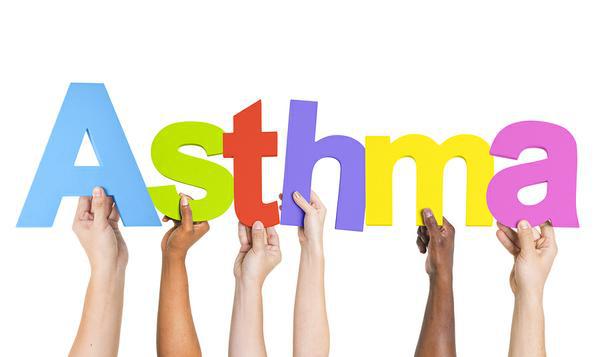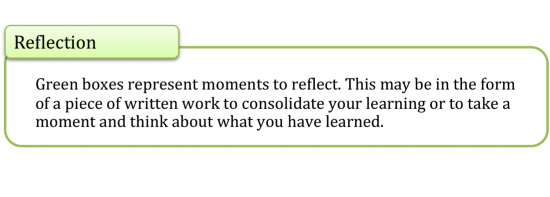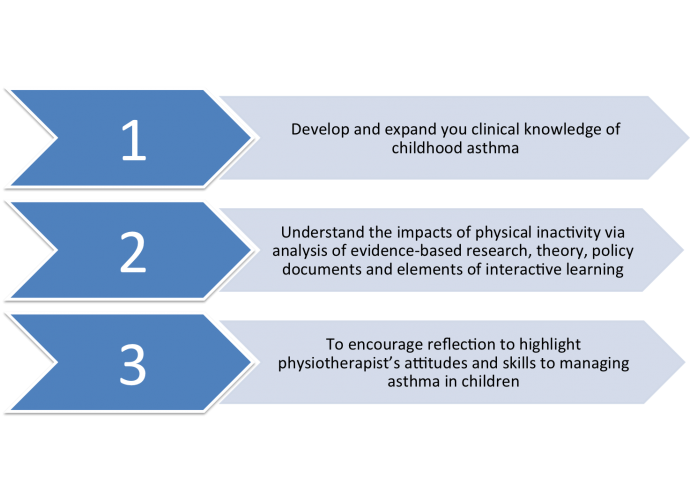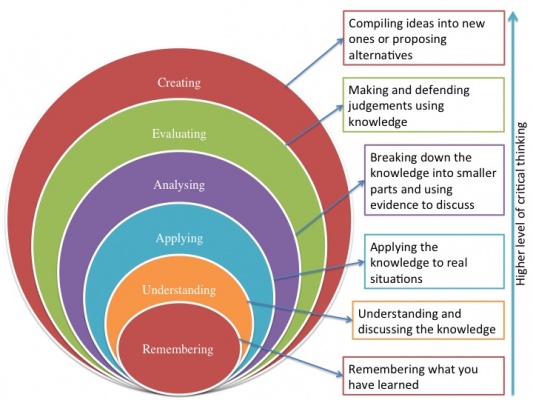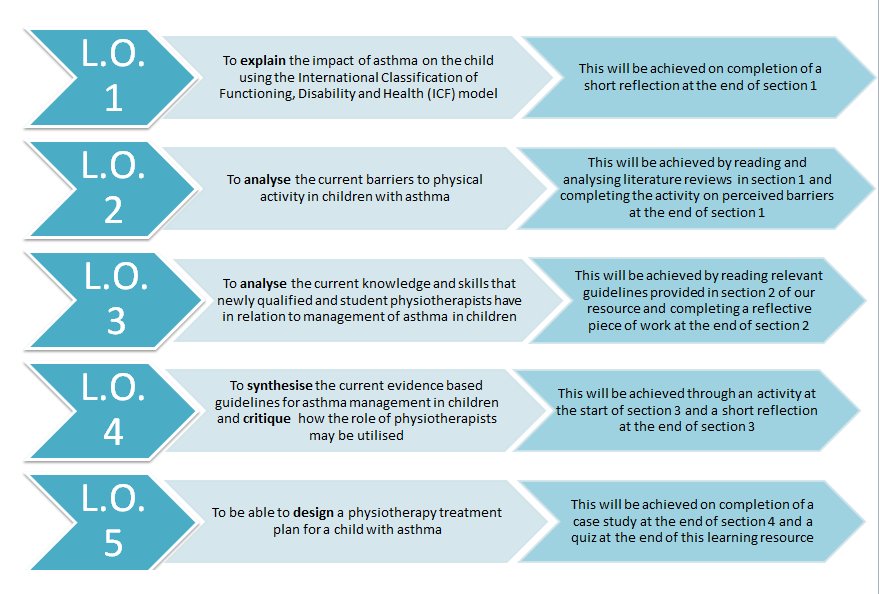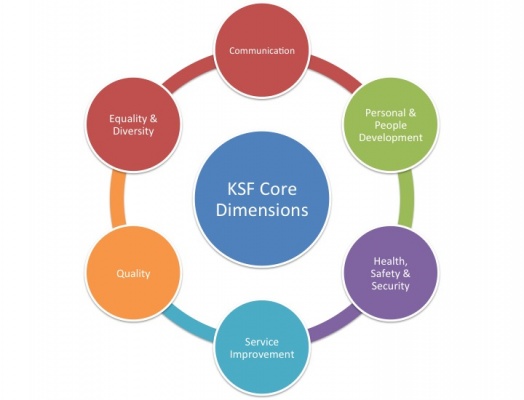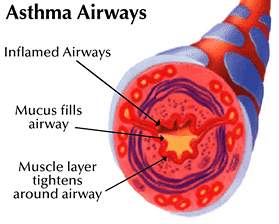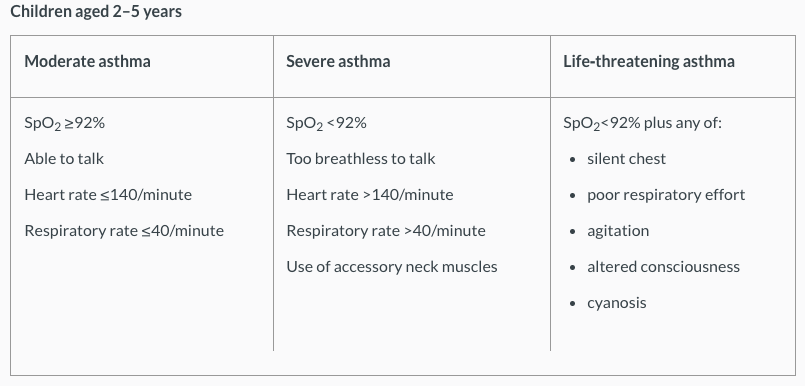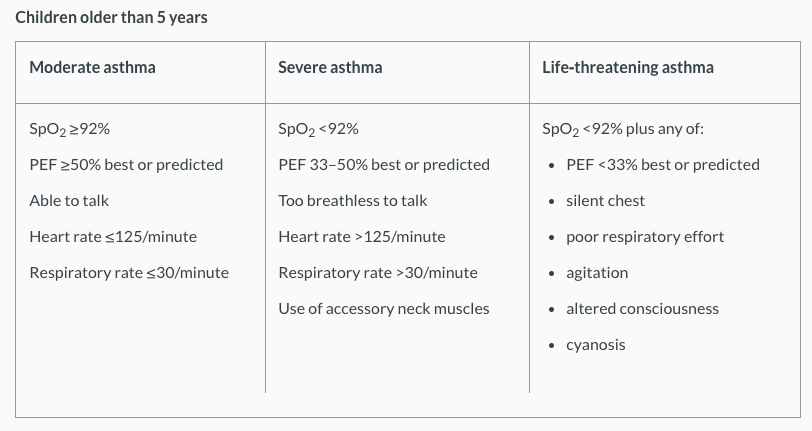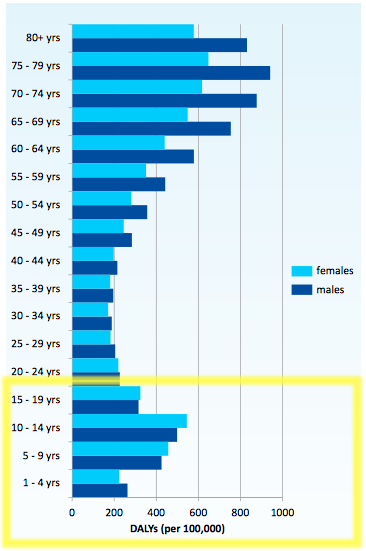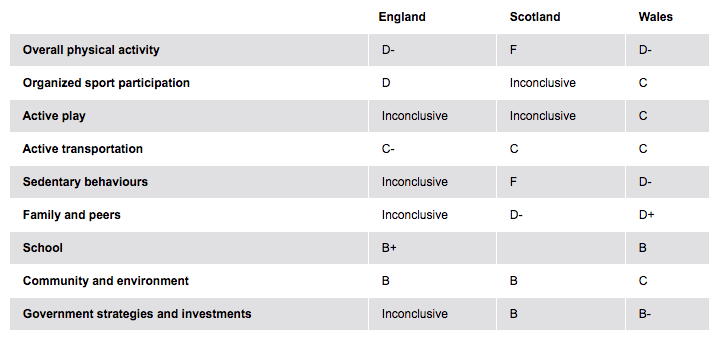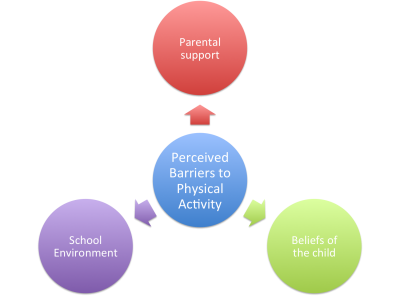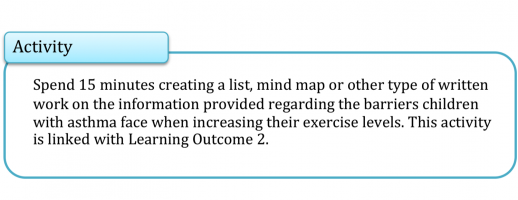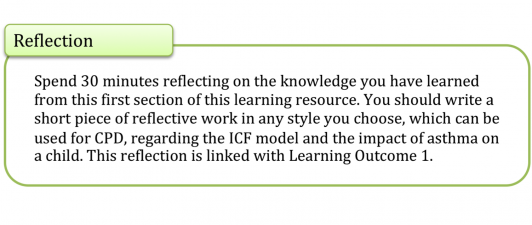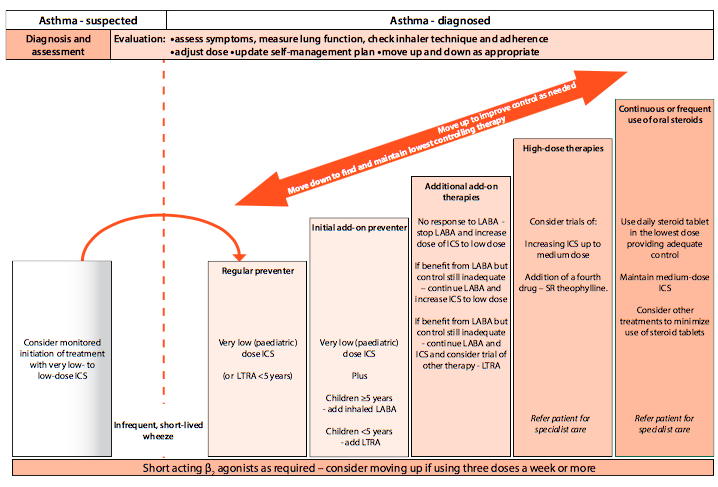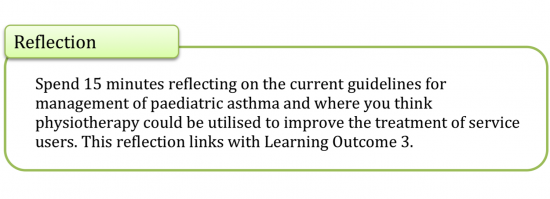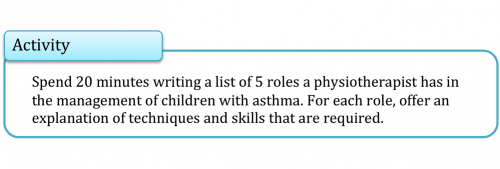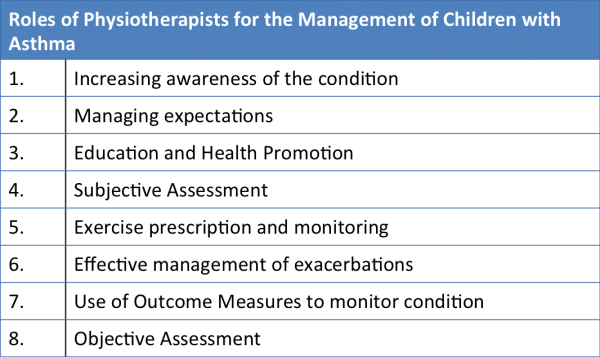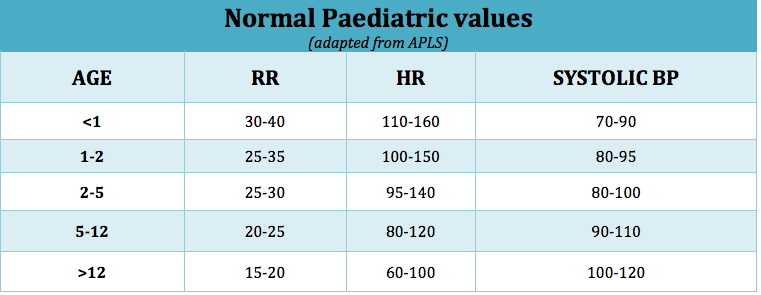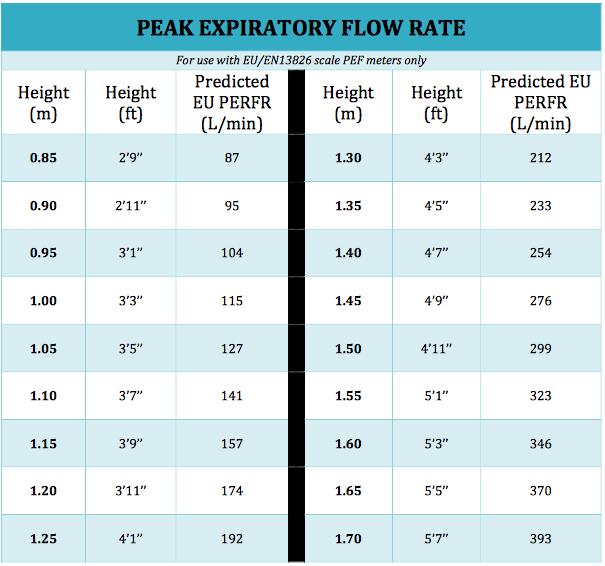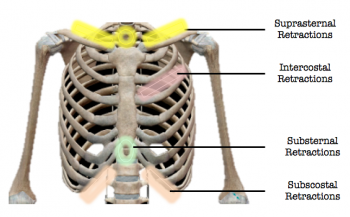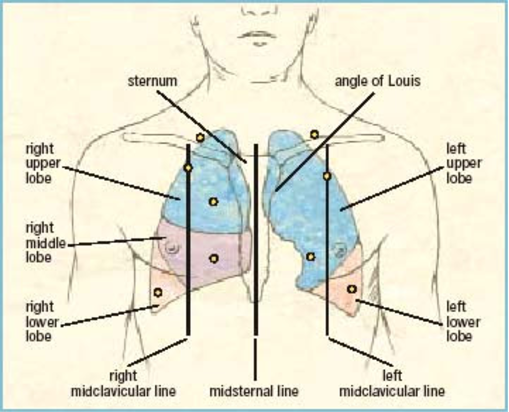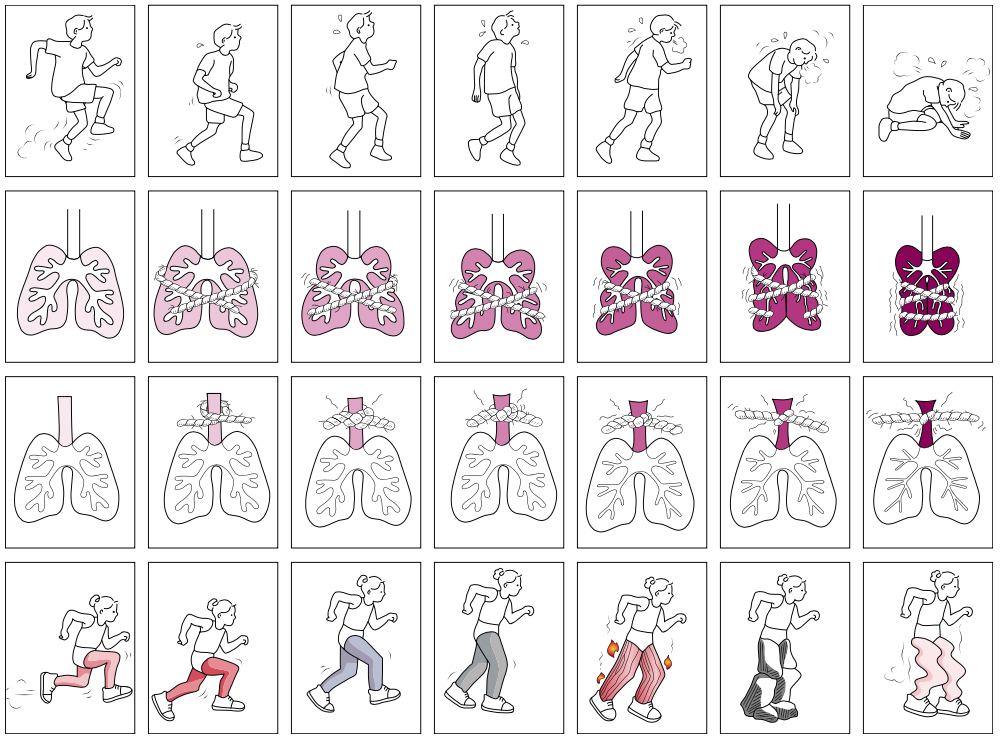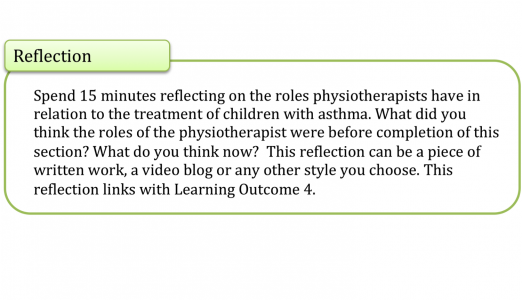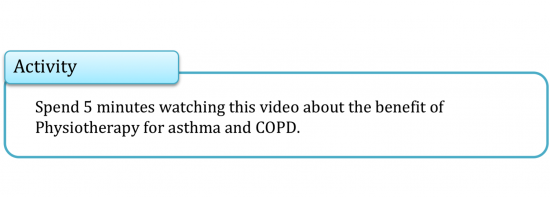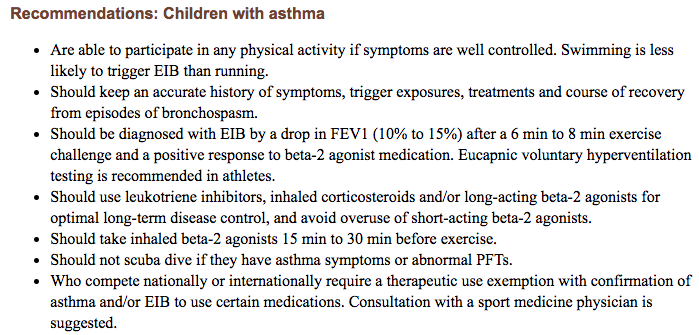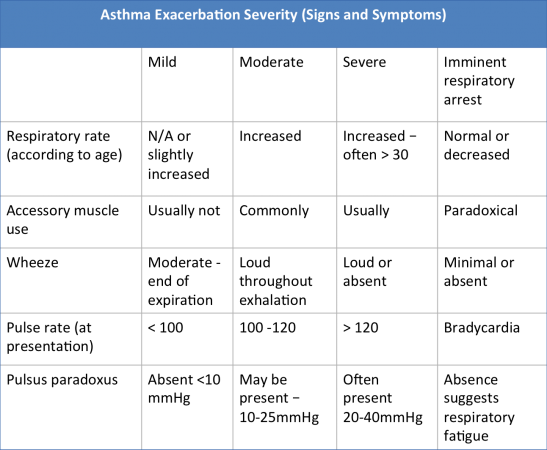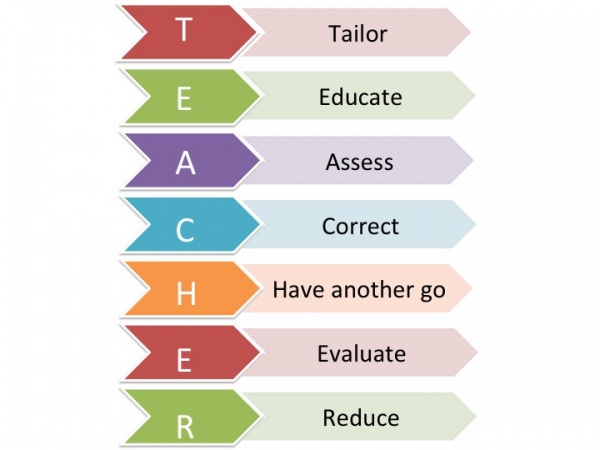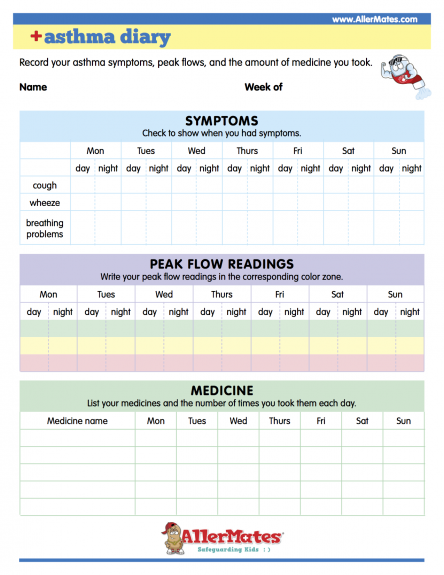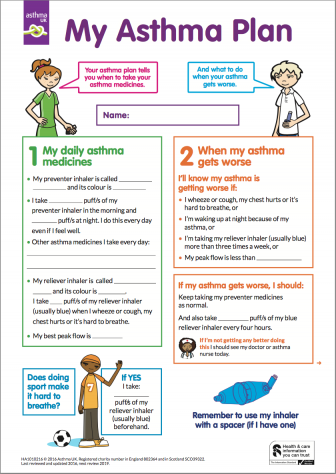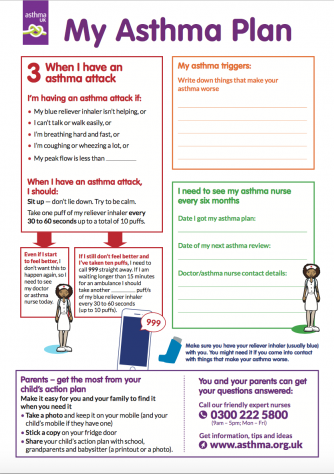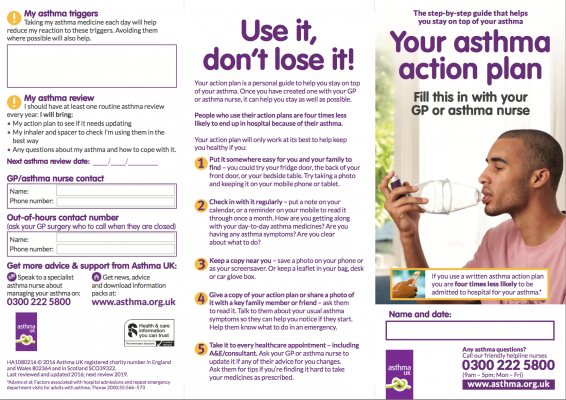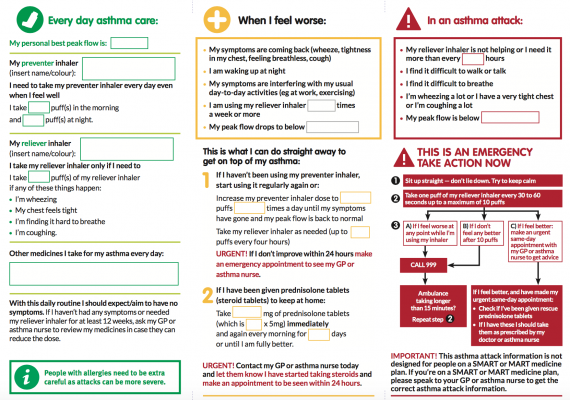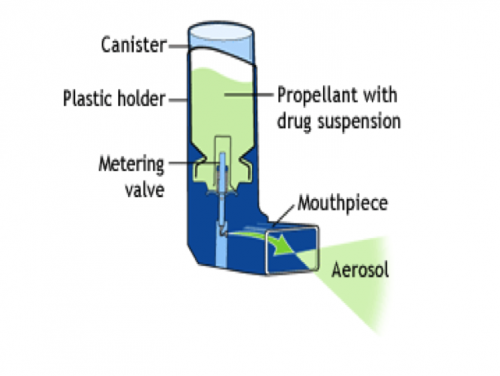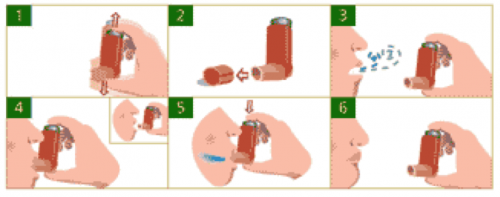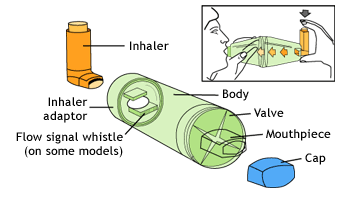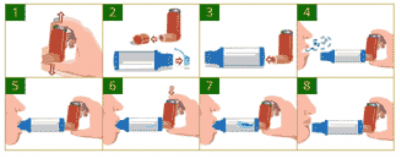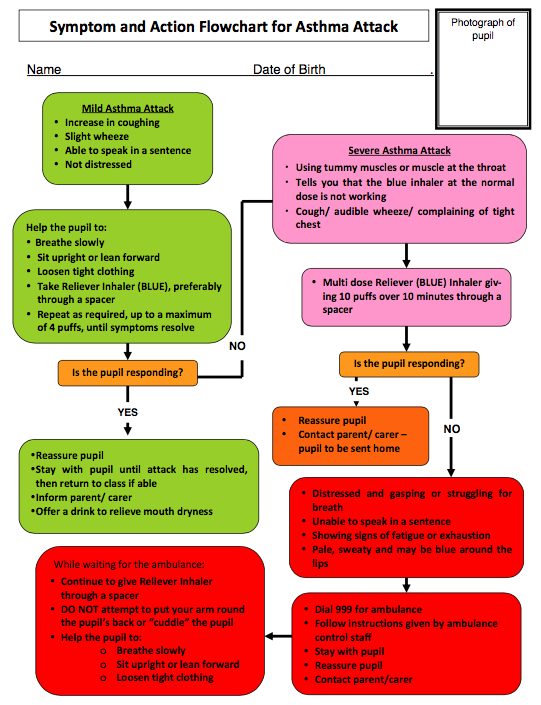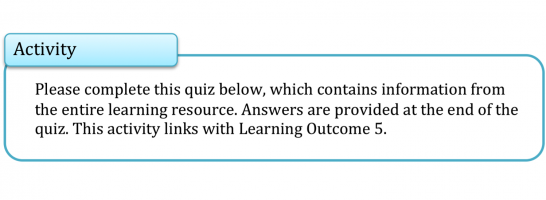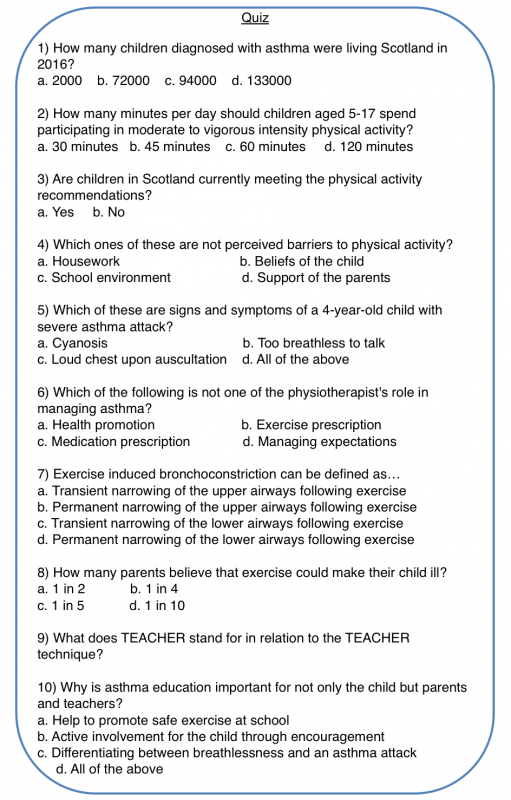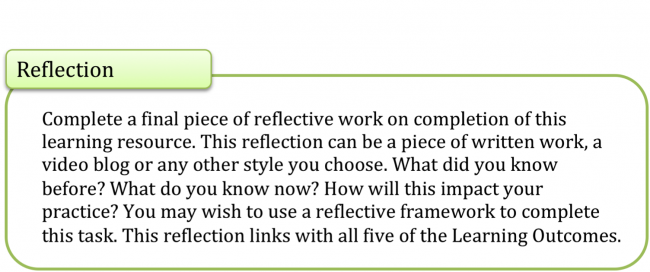Physical Inactivity in Children with Asthma: A Resource for Physiotherapists
Contributors: Amy Murray, Chrisostomos Koutsos, David Cowan, Rui Ling Lee, Shuen Wen Lim and Tommy Flanagan.
Introduction[edit | edit source]
Welcome to this online Physiopedia resource on Physical inactivity in children with Asthma: A Resource for Physiotherapists. This page has been designed by a group of 4th Year Physiotherapy students from Queen Margaret University in Edinburgh, as part of the Contemporary and Emerging Issues in Physiotherapy module.
Why is there a need for this resource?[edit | edit source]
Childhood asthma is the most common chronic illness in the world[1]. The UK has among the highest prevalence rates of asthma symptoms in children worldwide, with 1 child being admitted to the hospital every 20 minutes for an asthma attack[2]. This highlights that there is a significant proportion of children suffering from this illness. Despite global efforts to raise awareness of the importance of physical activity and the benefits that follow[3], children with asthma are still engaging in less physical activity due to their perceived barriers[4]. This strongly suggests the need for education to change the misguided beliefs that exercise will do more harm than good. Although there are organisations such as Asthma UK[2], SIGN[5] and NICE[6] in place to raise awareness of asthma management in children, these current guidelines only emphasise the importance of pharmacological interventions. There are gaps as to what physiotherapy services can offer to a child with asthma. Therefore, there is a need for this resource to equip physiotherapists with the appropriate knowledge and skills to handle asthma management in children and to promote health.
Layout and Approach[edit | edit source]
This online resource will take approximately 10 hours to complete and may be used for self-study or continuing professional development (CPD). However, this should be viewed as a rough guide due to the diverse learning styles and preferences people possess. In order to facilitate this, the resource has been split into several sections, which enables the user to undertake the learning and activities as and when required. Users can choose to complete the resource on their own, with fellow work colleagues and managers or as a group with feedback given on the appropriate section. Within the ten hours spent to complete this online resource, all five learning outcomes listed below in Figure 3 should be achieved.
This learning resource has been designed to be informative, interactive and engaging for the user, with maximum benefit gained when full cooperation and application is shown. The user will be required to undertake in-depth reading, critical reflective practice, quizzes, watch videos and complete short clinical case studies to enhance and facilitate a deeper learning. As mentioned above, peoples learning styles vary considerably and due to life being multimodal there are seldom instances where one mode is used, or is sufficient, therefore a diverse range of material has been incorporated to address the different learning styles. Prior to beginning this resource it may be beneficial to undertake the VARK learning styles questionnaire in order to correctly identify your preferred learning style.
Included in the learning resource will be three different types of action boxes, which all have a different colour and require a different action. They are key points, activity and reflection, and will look as follows:
Although this online resource highlights in detail many of the skills and resources needed when managing physical inactivity in children with asthma, further guidance and training may be required for application within clinical practice.
Aims[edit | edit source]
This interactive online resource targeted at final year physiotherapy students and newly-qualified band 5 physiotherapists aims to:
Figure 1. Aims of this resource
Blooms Taxonomy[edit | edit source]
Blooms Taxonomy is a hierarchical of model of the cognitive domain of learning ranging from lower levels of knowledge and understanding to more advanced levels of analysis and synthesis[7]. This model helps to allow students and practitioners to analyse their thinking and create learning outcomes based on critical thinking[8]. The model is split into 6 sections as shown in figure 1. below in a circular model: Remembering, understanding, applying, analysing, evaluating and creating.
- Remembering: This involves remembering what you have learned.
- Understanding: This level involves understanding the knowledge and being able to discuss it.
- Applying: This involves being able to apply the knowledge to real life situations.
- Analysing: This level involves breaking down knowledge and being able to use evidence to discuss each part of the learning.
- Evaluating: This level involves being able to make judgements and defend them using the knowledge you have gained.
- Creating: This final and highest level of critical thinking involves compiling ideas into new ones or proposing alternative ideas.
According to Bouchard[9] the 3 highest levels (analyse, evaluate, create) are the levels more directly related to allowing us to think critically and ethically, giving us the best potential for writing learning outcomes or objectives.
Figure 1. Bloom's Taxonomy
Learning Outcomes
[edit | edit source]
The figure below (Figure 2.) outlines the five learning outcomes of this online resource and how they will be achieved. These have been formulated using blooms taxonomy in order to establish the appropriate level of proficiency which is expected of newly qualified band 5 physiotherapists with particular reference to the Knowledge and Skills Framework (KSF).
Figure 2. Learning Outcomes
How this resource relates to the Knowledge and Skills Framework (KSF)[edit | edit source]
The KSF is a template for basing professional development as the career of the physiotherapist progresses[10]. The KSF ensures that physiotherapists demonstrate specific attributes to enhance efficiency, teamwork, effectiveness and patient satisfaction. Through this online resource, the vast majority of the core dimensions of the KSF will be addressed, equipping learners with the necessary skills required of a band 5 physiotherapist within the NHS.
This online resource will allow you to achieve the following key indicators as shown by the figure below:
1) Communication
- Communicate with a range of people (children, parents, other professionals) in an appropriate manner
- Develops ability to manage barriers to effective communication
2) Personal and people development
- Assesses and identifies what has been helpful in this learning resource via reflective accounts
- Application of knowledge and skills
- Takes responsibility for own personal development and takes an active part in learning opportunities
- Offers information to others when it will help their development or meet their work demands
Figure 3. KSF Core Dimensions
3) Quality
- Works within the limits of own competence and levels of responsibility and accountability in the work team and organisation
- Uses and maintains resources efficiently and effectively and encourages others to do so
4) Equality and diversity
- Recognises people's rights and acts in accordance with legislation, policies and procedures
- Acts in ways that respect diversity and view people as individuals
5) Assessment and treatment planning
- Passes onto the appropriate person constructive views and ideas on improving services for users and the public (online resource learner can promote the concept of the Respiro Initiative in Barcelona to enhance the validity of treatment resources for the public)
How much do you know about Asthma?[edit | edit source]
According to the Global asthma report which was produced in 2014 by the Global Asthma Network[11] (GAN) the most recent revised estimate is said to be approximately 334 million people that suffer from asthma worldwide and therefore the burden of disability is extremely high. This figure is inclusive of both adults and children. GAN is part of a worldwide collaboration that includes over half of the world's countries in order to statistically analyze asthma and its potential difficulties it can cause, in order to provide data required by the World Health Organisation[12].
So how much do you know about Asthma?
Section 1: Background[edit | edit source]
Section 1 refers to learning outcome numbers 1 and 2 which covers the explanation of the impactof asthma on the child and the analysis of current barriers to physical activity for children with asthma.
Childhood Asthma[edit | edit source]
According to the the United Nations Convention of the Rights of the Child, a child is defined as everyone under the age of 18 unless, "under the law applicable to the child, majority is attained earlier"[13].
Definition, Incidence and Prevalence[edit | edit source]
Asthma is an inflammatory disorder of the airways characterised by “paroxysmal or persistent symptoms such as dyspnea, chest tightness, wheezing, sputum production and cough, associated with variable airflow limitation and a variable degree of hyperresponsiveness of airways to endogenous or exogenous stimuli”[14].
Figure 4. Asthma Airways
Exercise-induced bronchoconstriction (EIB), defined as the transient narrowing of the lower airways following exercise, is common among adolescents[15]. In the UK, approximately one in every 11 children are currently receiving treatment for asthma[2].
Causes and Classification[edit | edit source]
According to the Asthma UK 2016, there are different kinds of asthma triggers. For this resource, we have identified triggers that are more relevant to children:
- Animals and pets
- Colds and flu
- Emotions
- Exercise
- Food
- House dust mites
- Indoor environment
- Moulds and fungi
- Pollen
- Pollution
- Smoking and second-hand smoke
- Stress and anxiety
- Weather
The table below classifies asthma severity for children aged between 2-5 years:
Table 1. Asthma severity for children aged 2-5 years.[16]
For more information, please refer to https://www.nice.org.uk/guidance/qs25/chapter/quality-statement-7-assessing-severity
The table below classifies asthma severity for children aged over 5 years:
Table 2. Asthma severity for children older than 5 years. [17]
For more information, please refer to https://www.nice.org.uk/guidance/qs25/chapter/quality-statement-7-assessing-severity
Statistics[edit | edit source]
Figure Burden of disease, measured by disability adjusted life years (DALYs) per 100,000 population attributed to asthma by age group and sex.
Global population, 2010. Source: Institute for Health Metrics and Evaluation (IHME).
In Scotland, 368,000 people (1 in 14) are currently receiving treatment for asthma. This includes 72,000 children and 296,000 adults[2].
Asthma is the most common chronic illness among children making up for 1 in 5 of all GP consultations.
On average, there are three children with athma in every classroom with asthma.
The prevelence of chldhood asthma in the UK is among the highest in the world.
A child is admitted to hospital due to an asthma attach every 20 minutes in the UK.
Developed by Asthma UK, the SAS visual analytical data can pull together information from locations all over the UK to see the prevalance rates, hospital admissions and percentage of population in the UK that have asthma and actively seek treatment for this.
Please click on the following link to acces the Asthma Uk analytic tool: Asthma UK, SAS Visual Analytical Data
Physical Activity[edit | edit source]
Definition, Incidence and Prevalance[edit | edit source]
The World Health Organization (WHO) defines physical activity as “any bodily movement produced by skeletal muscles that requires energy expenditure”[3].
Children and adolescents aged 5-17 years old are recommended to do at least 60 minutes of moderate to vigorous-intensity physical activity daily, including muscle and bone strengthening activities at least 3 times a week[3]. Even with the knowledge of the benefits of physical activity, participation rate is reported to be insufficient worldwide. Globally, for adolescents that are aged 11-17 years old, it has been found that 81% of them were insufficiently physically active in 2010[3]. In Scotland, the Scottish Health Survey in 2015 established that 27% of children aged 2-15 years did not meet the physical activity recommendations, which included school-based activity[18].
Children with asthma are generally less active than their healthy peers[19]. A study by Lang et al. found that children with asthma did an average daily physical activity of 116 minutes compared to that of healthy children of 146 minutes, and children with asthma only did less than 30 minutes of physical activity a day[20]. Children with moderate-to-severe asthma were also found to have lower physical activity levels than children with mild asthma[21].
Sedentary Behaviour[edit | edit source]
Definition, Incidence and Prevalance[edit | edit source]
The Sedentary Behaviour Research Network (SBRN) defines sedentary behaviour as “any waking activity with an energy expenditure ≤ 1.5 metabolic equivalents and a sitting or reclining posture”[22]. The American Academy of Pediatrics recommends children and adolescents to reduce their sedentary behaviour to less than 2 hours per day[23].
Statistics of Physical Activity and Sedentary Behaviour[edit | edit source]
The table below compares physical activity in children between England, Scotland and Wales:
Table 3. Children's activity across UK
For more information, please refer here
Relationship Between Physical Activity, Sedentary Behaviour and Obesity in Children with Asthma [edit | edit source]
Physical activity is essential for the normal growth and development of children and adolescents[24][25][26]. 60 minutes of physical activity a day has been shown to improve a child’s cardiovascular and bone health, improve their self-confidence and allow development of new social and motor skills[27][28]. It can reduce sedentary behaviour[29], and is crucial in the prevention of becoming overweight and obese[30][26], and can contribute to present and future health and wellness by imprinting healthy behaviour habits, reducing risk of future chronic disease[28].
There is evidence to show that physical activity can improve the asthmatic child’s aerobic and anaerobic fitness[30]. Physical activity engagement can also reduce school absenteeism, doctor consultations, reduce medication[31], and improve the child’s ability to cope with asthma[32].
There is evidence to show that physical activity can improve the asthmatic child’s aerobic and anaerobic fitness[30]. Physical activity engagement can also reduce school absenteeism, doctor consultations, reduce medication[33], and improve the child’s ability to cope with asthma[32].
Impact of Asthma on Physical Activity Using the ICF Model
[edit | edit source]
The International Classification of Functioning, Disability and Health (ICF) model is a classification of health and health-related domains and describes how people live with their health condition[34]. According to the ICF, asthma can influence participation of the child in areas such as sport, school activities, social impact and quality of life (van Gent et al. 2008). Personal and environmental factors such as their parents and asthma education can also play a role in how children with asthma function. The figure below (Figure 5.) shows the ICF model which has been adapted for children with asthma.
Figure 5. ICF Model related to a child with asthma
Perceived Barriers to Physical Activity
[edit | edit source]
There are 3 main perceived barriers that children with asthma face, which is shown in the figure below (Figure 6.), that are involved with the inability to undertake physical activity. These are: Parental support, beliefs of the child and school environment.
Parental Support
Parental activity-related support has the ability to influence a child’s physical activity levels[35]. A study done in 2004 showed that about one in five parents agree that exercise is harmful for children with asthma, and one in four parents are afraid that exercise would cause their child to fall sick[20]. Dantas et al established that 37% of mothers imposed restrictions to their children’s physical activity due to negative opinions about asthmatics doing physical activity, perception of children’s dyspnea after running on a treadmill, mother’s anxiety level and children’s asthma severity[36].
Beliefs of the child
Many children with asthma believe that limitations on their activity are an inevitable part of having asthma[37]. Williams et al.[19] also suggested that the desire to meet socially defined forms of normality or "ordinariness", thereby maintaining membership of a valued social group and avoiding stigma or social exclusion” appears to be an important factor affecting participation of physical activity in children with asthma. This may result in low levels of self-efficacy, especially when physical activity engagement is valued amongst their peers.
School environment
Studies have shown that a major problem for teachers were differentiating normal consequence of exertion from physical activity to breathlessness due to asthma[38]. Children may more likely be asked to sit out of physical activity in school so as to reduce the risk of an asthma exacerbation, thereby encouraging children with asthma to not participate in physical activity. Hence, it is important for school teachers to learn to recognise the right signs and symptoms so as to better manage the child’s condition and not send the wrong message to the child with regards to their activity participation.
Figure 6. Perceived barriers to physical activity
Section 2: Current Policies to Asthma Management[edit | edit source]
Section 2 refers to learning outcome number 3 which focuses on analyzing the knowledge and skills that need to be demonstrated by a physiotherapist for the management of a child with asthma.
Asthma UK[edit | edit source]
Asthma UK is organisation whose goals are to raise awareness of asthma and to support children suffering with asthma. It’s ultimate objective is raise funding for asthma research to potentially find a cure for asthma and new innovations in the treatment of asthma.
Asthma UK advocates the benefits of exercise in children with asthma and recommend they spend at least one hour a day doing some kind of physical activity. They feel as long as the child is managing their asthma well and keeing a good routine with taken their medication exercise will benefit them and improve their confidence about their asthma[2].
While asthma UK have clear guidelines on what to do in case of an asthma attack and how to handle it, they offer no clear guidance on the intensity or timing of exercise in children with asthma . This is an area of research which would greatly benefit physiotherapists in dealing with pediatric patients with asthma as will will allow use to design an exercise regime and treatment which is backed up by scientific evidence and is shown to be safe. This is an area in which the foundation could provide future research in especially as obesity in children becomes an increasing problem in Britain[39].
Scottish Intercollegiate Guidelines Network (SIGN) [edit | edit source]
While the SIGN guidelines provide similar information on what to do in case of an asthma attack, there is little focus on addressing the efficacy and effectiveness of physical exercise in children with asthma. There is a larger emphasis placed on the medical aspect of asthma management and allergen avoidance. In the SIGN guidelines for management of asthma (2016), there is only a short mention of improving dietary intake and incorporating exercise based interventions, however this is in relation to weight loss in children and not as a health management strategy in unison with medical management regardless of the child's weight factors.
This guideline in particular is focused almost entirely on the medical approach to managing symptoms. More specifically, in the section of the guideline concerning what a parent can do to help manage their child’s asthma, only the following three instructions are mentioned:
- Making sure the child takes their asthma medication when they should
- Avoiding exposure of the child to cigarette smoke
- Encouraging the child to lose weight if necessary[40]
Figure 7. shows a 5-step process of controlling asthma for children:
Figure 7. Stepwise management for children with asthma
For more information, please refer here
National Institute for Health and Care Excellence (NICE)
[edit | edit source]
NICE (2016a) state that there is no specific exercise plan for children who have asthma, and offer no time frame or intensity on the amount of exercise a child should do .They say it is appropriate to advise these patients regarding the precautions of exercise induced asthma and how to manage this[41]. Again this is a area in which the NICE guidelines could seek to improve by developing guidelines on the recommended timing and intensity of exercise for children with asthma.
Section 3: The Role of Physiotherapy[edit | edit source]
Section 3 refers to learning outcome number 4 which focuses on synthesizing current evidence based guidelines and critiquing the utiization of physiotherapists for the management of children with asthma.
Physiotherapists have a wide intervention scope for children with asthma however numerous newly-qualified physiotherapists are unaware of their extensive role for the management of respiratory conditions in children.
Prior to reading the description of the various roles of the physiotherapist in the management of children with asthma, complete the quiz presented below to understand your baseline knowledge:
It is noted that the abovementioned guidelines in Section 2 for managing asthma in children make no mention of the role of the physiotherapist as a member of the asthma symptom management team; it only emphasises the importance of pharmacological interventions. However, there is much that physiotherapy can offer in the way of asthma symptom management in children. The main roles physiotherapists have in relation to the management of childhood asthma are shown in the tables below (Table 4.):
Table 4. Roles of Physiotherapists for children with asthma
Increasing awareness of the condition[edit | edit source]
Increasing awareness about the nature of the condition including pathophysiology, asthma triggers and the progression of the condition with/without effective management. Details about the condition and its progression have been outlined in the previous sections of the page however it is the physiotherapist’s responsibility to adapt the information delivered depending on the age of the child as well as parental anxiety so as to not overload with information but at the same time deliver enough useful information.
Subjective Assessment [edit | edit source]
A diagnosis of asthma can be comfirmed based on various factors and symptoms. The patient is asked to explain their various symptoms, it is also important to hear the parents explain how they interpret the symptoms. You should as the patient to describe the frequency,duration and aggravating factors of their symptoms. It is important as a physiotherapist to know is they have been exposed to chemical fumes, dust or tobacco smoke as this might lead to the onset of asthmatic symptoms.It is also helpful to ask is their any family history of asthma or allergies as this makes the child more likely to be suffering asthmatic symptoms. While there is an increased risk of children of having asthma if their is a family link, it is believed that over 100 genes may be related to asthma and individual effect of any one of these genes on disease risk is quite small. Research is still being conducted to establish the genetic link in herediary asthma[42].
Symptoms[edit | edit source]
When carrying out a subjective assessment for a child with asthma it is important to find out the child’s opinion on his/her symptoms and the severity if they are able to communicate and the parent or guardians view on their symptoms.
Frequent, intermittent coughing – Children can have a persistent cough with an intermittent onset. If noticed by a parent It should be investigated. The child can also suffer from bouts of coughing which get worse when the child has respiratory infection[43]
Wheezing sound when exhaling – Children often present with a wheezing sound on exhalation. This is a strong indication of asthma that may persist throughout childhood and adult life[44].
Shortness of Breath - Struggling for breath even at rest and low levels of activity can be a symptom of asthma in children. Heavy and harsh breathing sounds are symptoms parents should look out for.
Fatigue – Asthma can cause children to sleep poorly, this can cause children to appear tired during the day even after having a full night’s sleep. This can affect performance and behaviour in school as well[45].
Chest pains & tightness – chest pains are particularly prevalent in younger children with asthma. Chest tightness can be accompanied by shortness of breath[46].
What do patients and parents know about asthma?[edit | edit source]
Medicine aspect – One study found that parents found it difficult to why doctors changed medication doses. It was felt that this was due to delayed diagnoses. The study also concluded that listening to parents opinions and including parent participation is important in regulating drug dose according to the symptoms ,to secure the lowest possible but effective drug dose[47]. Another study found that almost half of parents were using the asthma inhaler for cough medication than for its proper use. It also found that only 13% were administering aerosol therapy at home[48]
Attitudes of asthma - Studies carried out find that generally parents have a poor understanding of asthma. A sample of 100 parents were asked about their attitude towards there childs asthma with only 39% accepting the diagnosis and only 3 out of 100 knew exactly what asthma is. 26% of the parent also believed asthma was contagious and 35% believed asthma was a hereditary disease. However, this was a relatively small study size carried out on a homogenous population in India[48]. In another study it was pointed out that patients and parent felt that doctors didn’t pay enough attention to them describe symptoms and relied more on auscultations. Which was felt to contribute to a poor mutual understanding. The study also found that parents can recognise specific asthma patterns in their child often including behavioural changes. However, this was a study which included 30 children and 20 parents. Studies have also shown that parent can tend to overestimate the severity of their child’s asthma. This can have a negative effect on the treatment process[49].
Objective Assessment[edit | edit source]
Vital signs taking[edit | edit source]
- Heart rate (HR)
- Blood pressure (BP)
- Respiratory rate (RR)
- Oxygen saturation (SpO2)
- Peak Expiratory Flow (PEF)
Table 5. Normal paediatric values
For more information, please refer here
Table 6. Normal PEF values
For more information, please refer here
Inspection[edit | edit source]
General appearance
- Posture
- Sitting upright or tripod position - Nasal flaring
- Breathlessness in speech (assessing if the child can complete sentences in one breath)
- Cyanosis
Breathing
- Retractions: Indrawing of skin- Suprasternal (Tracheal tug): Middle of neck above sternum
- Substernal: Abdomen below sternum
- Intercostal: Skin between each rib
- Subcostal: Abdomen below rib cage
- Supraclavicular: Neck above collarbone - Use of accessory muscles
- Sternocleidomastoid
- Parasternal- Scalene
- Trapezius
Figure 8. Chest retractions
- Thoracic/Shallow breathing
- Paradoxical chest wall movement: Inward movement on inspiration and outward movement on expiration
Figure 9. Paradoxical chest wall movement
Chest wall configuration
- Barrel-shaped
- Anteroposterior diameter (May increase due to hyperinflation)
Cough
- Usually nonproductive accompanied by wheezing
Palpation[edit | edit source]
Scalene muscle contraction
Landmark for scalene muscles: Triangle bordered by clavicle (front), trapezius (back), and neck (medially) in line with ear lobe
Symmetry of chest movement
Auscultation[edit | edit source]
Lung fields
- Right anterior lung field (RUL & RML)
- Right posterior lung field (RUL & RLL)
- Left anterior lung field (LUL & LLL)
- Left posterior lung field (LUL & LLL)
Figure 10. Location of lung fields
Wheezing
Polyphonic, widespread, high-pitched
To listen to how a wheeze sound like, please refer here
Outcome measures[edit | edit source]
Asthma Control Test (ACT)[edit | edit source]
The ACT was developed as a tool to identify patients with poorly controlled asthma. It is a short, simple questionnaire that patients can do themselves to identify if their asthma may be poorly controlled. The questionnaire is age specific as they have a questionnaire with facial expressions aimed at kids 4 to 11 which makes it easier for them to identify their symptoms. Another asthma control test is aimed at children 12 years and older. A score of 19 or less identifies patients with poorly controlled asthma. The ACT has been shown to be reliable and responsive to changes in asthma management in patients[50].
Physical Activity Questionnaire for Children (PAQ-C) and Physical Activity Questionnaire for Adolescents (PAR-A)[edit | edit source]
The PAQ-C and the PAQ-A are validated self-report measures of physical activity widely used to assess physical activity in children aged 8-14 and 14-20 respectively[51]. Both and PAR-C and PAQ-A are self administered tests, measuring general moderate to vigorous physical activity levels. It is a low cost, reliable and valid assessment of physical activity from childhood through adolescence[51].
Paediatric Asthma Quality of life Questionnaire (PAQLQ)[edit | edit source]
The PAQLQ is a health-related quality of life assessment that can provide an idea of the functional impairments (Physical, emotional and social) of the paediatric patient that are important to the patients in their everyday lives[52]. The Paediatric Asthma Quality of life questionnaire (PAQLQ) is targeted for children aged 7-17 years and has 23 questions in 3 areas (Symptoms, activity limitation and emotional function). The activity domain contains ‘patient-specific’ questions. Children are asked to think about how they have been during the previous week and to respond to each of the 32 questions on a 7-point scale (7= not bothered at all- 1= extremely bothered)[52]. Calculation of the results involves taking the mean of all the 23 responses and the individual domain scores are the means of the items in those domains[52].
For information regarding the PAQLQ click here
Dalhousie Dyspnea and perceived exertion scale[edit | edit source]
The Dalhousie Dyspnea and perceived exertion scale is a pictorial scale that encompass the full range of the perception of breathlessness by children[53].
Areas tested:
· Breathing effort
· Chest tightness
· Throat closure
The image below (Figure 11.) shows 7 pictures which are used with increasing severity in each series[54]. This scale has been validated against the Perceived Exertion Scale in children 7 years or older with asthma or cyctic fibrosis.
Figure 11. The Dalhousie Dyspnea and perceived exertion scale
Paediatric Respiratory Assessment Measure (PRAM)[edit | edit source]
The PRAM is a valid and reliable objective assessment of asthma severity for children aged 2-17 years with acute asthma[55]. It is tested on a 12-point scale for 5 different areas (O2 saturation, suprasternal retraction, scalene muscle contraction, air entry and wheezing)[55].
3-hour PRAM scores can be used in clinical settings to facilitate the decision to admit or initiate more aggressive adjunctive therapy to decrease the need for hospitalization[56].
Section 4: Physiotherapy Management[edit | edit source]
Section 4 refers to learning outcome number 5 which focuses on designing a physiotherapy treatment plan for a child with asthma via a case study completion and quiz.
Exercise prescription [edit | edit source]
According to the American College of Sports Medicine (ACSM), children are required to partake in aerobic exercises, muscle strengthening and bone strengthening exercises[57]. These exercises are classified according to Frequency, Intensity, Time and Type of physical activity as shown in the tables below:
Aerobic exercise:
Table
Muscle strengthening:
Table
'Bone'strengthening:
Table
In relation to children with asthma, Philpott et al.[58] recommends the following as shown below:
Figure
For more information, click here
Effective management of exacerbations[edit | edit source]
Management of exacerbations. Asthma exacerbations in children can be categorized depending on severity and the demonstration of specific signs. It can be useful for the physiotherapist to be informed about signs of previous exacerbations so as to monitor the progression of the child’s asthma.
The table below (Table 7.) taken from Kumar 2014[59] is a useful guidance tool for asthma exacerbation severity:
Table 7. Asthma Exacerbation Severity (Signs and Symptoms)
Patient education and self-management[edit | edit source]
Delivering education to the affected child themselves, their family and their school especially in regards to participation in physical activity. Studies suggest that physical activity improves cardiopulmonary function without compromising lung function and does not have an adverse effect on wheeze for children with asthma[60]. Respiratory education for the child includes secretion clearance techniques, strengthening of the respiratory muscles and specifically timed inspirations and expirations can act as exacerbation preventative therapy. Interestingly, through respiratory education, the oxygenation of the brain is enhanced which has been shown to translate into improved academic performance and improved quality of life[61].
Asthma education is important in the child, parent and teachers. Asthma education for children can promote active involvement and facilitation of learning from other’s shared experiences, leading to improved confidence in their own strength and empowerment, as well as their sense of coherence (SOC) in managing their own condition[62]. However, educating the child with asthma about the feasibility and benefits of physical activity will not be effective if the family and school contexts are not also persuaded to encourage and facilitate participation[63][19]. Parents and teachers also need to be educated on how and when children with asthma can participate in physical activity, how to adjust medication before and during periods of extended activity and how to differentiate between limitations at times of asthma exacerbation and overall limitations.There is evidence to show that although medical advice were frequently cited by children and parents to explain reduced activity participation, it was in fact their beliefs about the capability of the child to manage the symptoms, safety of the physical activity and motivation of the child that most strongly influenced the child’s desire to take part in physical activity and their parents’ support[64].
Airway Clearance Techniques[edit | edit source]
Breathing techniques[edit | edit source]
A common sign of poorly managed asthma in children is superficial/clavicular breathing. In this type of breathing, expansion of the chest only occurs around the height of the clavicles upon inspiration, the neck muscles pull the first 2 ribs in an upward direction and the diaphragm and abdomen hardly intervene. The inefficiency of this breathing pattern due to its high energy expenditure for minimal gaseous exchange makes it a perfect starting point for respiratory education to introduce lateral, deeper breathing.
Studies suggests that cardiovascular endurance conditioning should be the key aspect of the physical activity a child with asthma receives[65]. Respiratory exercises enhance exercise tolerance and help build resistance against muscle fatigue. Balloon blowing; cotton-wool straw football exercises are excellent examples of games which are fun for children and simultaneously increase lung volume and improve gaseous exchange to improve quality of life in a relatively controlled manner[66].
Correct Inhaler Use[edit | edit source]
Proper inhaler use is vital to the good management of asthma in children. It is estimated that up to 25% of asthma sufferers use improper inhaler technique[67]. Improper inhaler uses has proven to correlate with poor asthma control and more frequent emergency hospital visits[68]. Poor technique is also associated with a lower quality of life and level of patient education is associated with poor inhaler technique[69]. As a result, correct inhaler technique is vital in the management of children with asthma exercising and physiotherapists should be able to properly demonstrate inhaler techniques.
The T.E.A.C.H.E.R acronym is a great way to ensure children are in receipt of the correct care, and that their programme is tailored specifically to them. The figure below shows what the acronym stands for:
Tailor – Tailor the method of delivery to suit your patient. Many younger children especially ones younger than 5 years old have difficulty timing breathing with the inhaler and a spacer is often used to remedy this problem. Children who have shallow patterns of breathing my also find using an inhaler difficult and benefit from using a spacer
Educate - Educate the child in the correct timing of when to trigger the inhaler and how to take a deep breath. Explain to the child the importance of using the inhaler and why having correct technique is vital.
Assess – Assess the patients technique, allow them to attempt using the inhaler independently without prompts. Focus on the timing of triggering the inhaler with their breathing. Pay close attention to any mistakes.
Figure 12. TEACHER Technique
Correct – After assessing the patients technique, correct the patient on any mistakes they may have made. Re enforce the areas in which their technique was successful and correct areas in which they need to improve.
Have Another go – Re assess the patients technique and see if it has improved after correction.
Evalute – Evaluate the childs technique and see it is of an adequate standard. If not correct and re assess again.
Reduce – Children are recommended to use their inhaler 15 minutes before physical activity and during in case of an attack. In general use a patient should be recommended to use the inhaler as conservatively as possible. Health care professionals should recommend reduction in inhaler usage if possible.
Safe breathlessness[edit | edit source]
As breathlessness is very subjective and can vary from person to person, choosing a point of safe breathlessness is very much down to the individual. There are no guidelines to determine what is classed as safe breathlessness, therefore parents, teachers, family members and clinicians must take a very subjective approach to this. Children should be encouraged to exercise, but stop if breathlessness gets worse than their perceived normal level. When completing a subjective assessment on a child with Asthma, a visual breathlessness scale should be used to aid children with where they sit on the scale, similar to a VAS scale for pain[70]. The Dalhousie Dyspnea and perceived exertion scale[53] is an example of this - as shown in our section regarding outcome measures - and allows the child to pick where they think they are on the scale to determine their level of breathlessness.
Asthma Diary[edit | edit source]
Effective management of your asthma is not solely based on administering the correct medication at the correct times and dosage. This is of course one of the most important aspects in order to keep your asthma well controlled, but by no means the only option. Asthma is an extremely variable condition and no two people’s asthma is likely to be identical. This emphasises the importance of education being an integral aspect of all interactions between the health care professionals and patients, and relevant to asthma patient’s of all ages. Although the focus of education for young children will predominantly be on the caregivers and parents, children as young as 3 years old can be educated on simple asthma management skills and personal triggers. Research by Shah et al. 2001[71] and Trollvik et al. 2013[62] showed that although adolescents may have some degree of difficulty in adhering to asthma education, this could be enhanced through peer support group education with the added support of education given by the health care professional.
Management can be made easier by the application of an Asthma Diary, which can be made as simple or detailed as you require. However, the more detailed the information is the more beneficial it will be, not only for your child but also the asthma nurse or doctor, who can systematically tailor your treatment to your needs. Identification of what triggers your child’s asthma can sometimes be easily identifiable, however at times it can be complex, therefore keeping a daily asthma diary could help.
The asthma diary[72] (Figure 13.) includes a record of:
- Symptoms: This would be beneficial to keep a record, so you can monitor whether your symptoms get better or worse over time. Recording the time when symptoms are worse and what triggered them would be of great benefit so measures can be undertaken to address these issues.
If you notice any of the following symptoms such as:
- Frequent waking throughout the night suffering from excessive coughing, wheezing and shortness of breath.
- Administration of the reliever treatment at a much greater rate than normal, or if this doesn’t seem to be working in any way.
- Upon wakening in the morning, you suffer from shortness of breath.
- Finding it increasingly difficult to participate in your usual level of activity.
- Then the most important thing is to phone your doctor who can administer the correct treatment, which can help you bring your child’s asthma back under control.
- Peak Flow Readings: The peak expiratory flow measurements are made using a peak flow meter (PEF), which can be important in the diagnosis and monitoring of asthma. Modern PEF meters are relatively inexpensive, portable, plastic and ideal for children to use in the home setting for day-to-day objective measurements of airflow limitation. The PEF is a measure of the highest expiratory flow that can be generated following the child’s maximal inspiration. The reading will directly be influenced by airway diameter and can be a useful indication of the degree of bronchoconstriction in asthma sufferers[73].
Figure 13. Asthma Diary
For more information, please refer here: Asthma Diary
- Medication
This is extremely important to record both the various forms of medication the child takes and also the timeframe the medication was administered. This also includes any other types of medication they use, such as over the counter remedies.
This information will allow the doctor or practice nurse to monitor how well controlled the child’s asthma is and how effective the medication is in controlling the asthma symptoms. Therefore, clinical decisions can be made whether to change, increase or decrease the medication to gain or maintain control[74].
The asthma diary would also benefit from the recording of the child’s participation in daily activities and the effect these have on asthma symptoms. For example, the child may feel their asthma is well controlled but notice some degree of difficulty when participating in certain exercise or even running for the school bus. Recording of this information will allow your doctor or asthma nurse to generate a written self-management action plan, which is tailored to your child’s needs. According to the SIGN[5] guidelines on the management of asthma, all patients of all ages should be offered self-management education, which should also include the development of a personalised asthma action plan. Research has shown that symptom-based written plans for children are effective in reducing emergency consultations[75][76].
Asthma Action Plan[edit | edit source]
Since all children who are diagnosed with asthma are susceptible to asthma exacerbations at some point in time, knowing how to manage and prevent these episodes is extremely important[77]. Active participation from the parent or individual with asthma in order to prevent exacerbations has led to the universal recommendation by both international and national guidelines to advocate the importance of asthma education for all affected patients, including the provision of a set of written instructions, often named Written Asthma Plans (WAP) or self-management action plans, to guide prevention and successful home management of symptoms and exacerbations[78][79][80].
A systematic review, which examined written asthma plans in children, concluded that there were significant reductions in acute care visits, children achieved better attendance records at school, had less nocturnal awakening and reported improved symptom scores when provision of a written action plan was implemented[76]. Research has shown that for children and adolescents, written asthma action plans that are based on symptoms seem to be more effective than those based on peak expiratory flow[76][75].
Using a written asthma action plan means:
• You can share this with anyone who is looking after your child such as carer, family member or teacher at the child’s school.
• You can use it if your child is suffering an asthma attack – it can be beneficial when the parent or caregiver is panicking or even during the middle of the night when it is difficult to be fully alert.
• That the information about your child’s asthma is all written in one place which will give you peace of mind that the correct procedures will be followed if your child’s symptoms begin to deteriorate.
• Your child is less likely to suffer an asthma attack or have asthma symptoms[2].
In order to get the best from the asthma action plan it is important to discuss each section in detail with the child’s GP or asthma nurse and ask any questions needed. If the child is at an age where they can be involved it is important to include them in the discussion so effective self-management can be incorporated. Preparing children with asthma to take independent responsibility for their own asthma management and empowering them to show they are capable of doing so, is significant when understanding how their asthma is being looked after[78].
The asthma action plan should be taken to all regular asthma reviews so adaptions can be made if necessary. Keep the asthma plan in an obvious place so access can be gained from a number of people and found easily, even a copy can be kept on the child’s phone if this is applicable[2].
(Figure 14. Asthma Action Plan under 12 years) (Figure 15. Asthma Action Plan under 12 years)
Further information on the child's asthma action plan can be found here: Asthma UK Action Plan
(Figure 16. Asthma Action Plan For Over 12's Part 1)
(Figure 17. Asthma Action Plan for Over 12's Part 2)
Further informtaion on the Over 12's Asthma Action Plan can be found here: Asthma UK Action Plan for Over 12's
Bronchodilators: The Correct Use
[edit | edit source]
A metered-dose inhaler, called an MDI for short, is a pressurized inhaler that delivers medication by using a propellant spray. A picture of the metered dose inhaler can be found to the right (Figure 18.).
Using a Puffer
- Shake the inhaler well before use (3 or 4 shakes)
- Remove the cap
- Breathe out, away from your inhaler
- Bring the inhaler to your mouth. Place it in your mouth between your teeth and close you mouth around it.
- Start to breathe in slowly. Press the top of you inhaler once and keep breathing in slowly until you have taken a full breath.
- Remove the inhaler from your mouth, and hold your breath for about 10 seconds, then breathe out.
Figure 18. Metered Dose Inhaler
The diagram to the left shows the steps stated above in picture form as an example of how to take your MDI.
If you need a second puff, wait 30 seconds, shake your inhaler again, and repeat steps 3-6. After you've used your MDI, rinse out your mouth and record the number of doses taken. All puffers should be stored at room temperature.
Figure 19. How to use a MDI
Here are some important reminders about metered dose inhalers[81]:
- Always follow the instructions that come with your MDI.
- Keep your reliever MDI somewhere where you can get it quickly if you need it, but out of children's reach.
- Show your doctor, pharmacist or asthma educator how you're using your metered-dose inhaler.
- Store your MDI at room temperature. If it gets cold, warm it using only your hands.
- Never puncture or break the canister, or try to warm it using anything except your hands.
- When you begin using an MDI, write the start date on the canister.
- Check the expiry date on the MDI before you use it.
- If you're having trouble using your MDI, ask your doctor for tips or to recommend another device.
- Many doctors recommend the use of a spacer, or a holding device to be used with the MDI.
- Do not float the canister in water.

Using a Spacer
- Shake the inhaler well before use (3-4 shakes)
- Remove the cap from your inhaler, and from your spacer, if it has one
- Put the inhaler into the spacer
- Breathe out, away from the spacer
- Bring the spacer to your mouth, put the mouthpiece between
- your teeth and close your lips around it
- Press the top of your inhaler once
- Breathe in very slowly until you have taken a full breath. If you hear a whistle sound, you are breathing in too fast. Slowly breath in.
- Hold your breath for about ten seconds, then breath out.
Figure 20. Diagram of a MDI with a spacer
Important Reminders About Spacers[82]:
- Always follow the instructions that come with your spacer. As well:
- Only use your spacer with a pressurized inhaler, not with a dry-powder inhaler.
- Spray only one puff into a spacer at a time.
- Use your spacer as soon as you've sprayed a puff into it.
- Never let anyone else use your spacer.
- Keep your spacer away from heat sources.
- If your spacer has a valve that is damaged, or if any other part of the spacer is damaged, do not use it. The spacer will have to be replaced.
- Some spacers have a whistle. Your technique is fine if you do not hear the whistle. However, if you hear the whistle, this means you should slow your breath down
Figure 21. How to use a MDI with a spacer
Managing expectations[edit | edit source]
Managing expectations initially refers to ensuring that the child’s understanding of their condition, their role in its management and their paticipation in physical activity is accurate and realistic. Managing these expectation occurs from the moment of the diagnosis and as the child gets older, with varying levels of detail according to the child's age and understanding. The physiotherapist is also responsible for managing the expectations of the child’s carers which often includes overcoming barriers to physical activty that parents have set for their child due to fear of an exacerbation. Once carers are aware of the value of well-controlled asthma via medications and safe physical activity, their expectations are often positively influenced.
Health Promotion[edit | edit source]
Recommended Physical Activity Guidelines[edit | edit source]
Children with asthma should be encouraged to lead a healthy, active lifestyle. While it is well known that healthy children should perform at least 60 minutes of physical activity a day, the same physical activity recommendations also applies to children with asthma[28]. Adjustments or restrictions however, to the frequency, intensity, duration, or type of physical activity permitted for each child should be appropriately done so to reduce the risk of a physical activity-related adverse event (Bar-Or and Rowland 2004). Children with asthma should use inhaled β-2 agonists 15-30 minutes prior to beginning exercise (Riner and Sellhorst 2013), and do adequate warm up exercises to reduce asthmatic symptoms especially during cold weather (Asthma UK 2016).
Considerations for Children with Asthma[edit | edit source]
Figure 22. Symptom and action flowchart in the case of an asthma exacerbation
Evidence Based[edit | edit source]
1) Physical training for asthma - Cochrane database[83] (high-quality evidence)
Reason for study:
Decreased exercise tolerance is observed in people with asthma due to worsening symptoms during physical exertion and a gradual deconditioning due to inactivity.
Previous studies have used a variety of training protocols to improve physical fitness, neuromuscular coordination and self confidence in people with asthma with varying levels of consideration to the safety of exercise which can potentially induce asthma.
Study objectives:
Explore randomized trials (21 studies, 722 participants) to analyze the effect of physical training on respiratory and general health of people with asthma.
Study results:
Physical activity was well tolerated with no adverse effects.
No mention of worsening asthma symptoms during or following physical activity.
Physical activity produced:
Improved cardiopulmonary fitness via increased maximum oxygen uptake
No statistically significant effects on forced expiratory volume in 1 second (FEV1)
No statistically significant effects on forced vital capacity (FVC)
No statistically significant effects on minute ventilation at maximal exercise (VEmax)
No statistically significant effects on peak expiratory flow rate (PEFR)
Study conclusions:
Physical training showed significant improvement in maximal oxygen uptake however had limited effects on other measures of pulmonary function.
Physical training is well tolerated by people with asthma therefore asthma sufferers should be encouraged to participate in regular exercise training rather than allowing the fear of symptom exacerbation to limit their participation.
Value of study for us:
This high-quality study emphasises the positive effects of physical activity for people with asthma while highlighting the need for further research to understand the mechanisms by which physical activity influences asthma management.
The study compared numerous randomized trials based on adults with asthma therefore the exact application of the results to peadiatric populations cannot be known. The study does manage to decrease the fear aspect of participating in physical training for asthma patients.
2) Breathing exercises for children with asthma - Cochrane database
Reason for study: Hyperventilation and lung hyperinflation are two symptoms of asthma. Breathing exercises focus on attempting to reduce these symptoms and as a result normalise C02 levels which may reduce bronchospasms and breathlessness. These breathing technique may also help to reduce anxiety associated with asthma symptoms potentially could have a positive impact on the patient's quality of life. Therefore breathing exercises in people with asthma may provide a psychological benefit by increasing people's sense of control over their asthma.
Study objectives : The main objective of this clinical trial was to explore the effectiveness of breathing exercises to achieve and clinically control asthma. Methods such as the buteyko breathing technique, papworth method, yoga and similar interventions that aim to manipulate breathing patterns were investigated to study their impact. This is seen as important as although these breathing exercises are commonly used there is no consensus regarding the effectiveness of breathing exercises in controlling asthma. This systematic review goal is to critically evaluate previous studies and see is is any there is a consensus on if breathing exercises have a positive impact on people with asthma.
Study results : The review included 3 studies with 112 participants ranging from 6 to 13 years old. All three studies performed the comparison breathing exercises as part of a more complex intervention against a control. None of the studies compared breathing exercises alone with a control. The study measured quality of life, asthma symptoms,reduction in medication usage,number of acute exacerbations and lung function. The control groups in the 3 trials received different placebos , one being an educational programme and doctors appointment the other wasn’t described.In the 3 st
udies there was no difference in the primary outcome reported between the study group and the control group.
Study conclusion: This review showed that breathing techniques in conjuction with other asthma control techniques such as exercise have a postive impact on asthma control. However no reliable conclusion on the use of breathing exercises alone for children with asthma could be drawn from this systematic review. This is part is due to the breathing exercises being part of a comprehensive package of care looked at in each study and the breathing exercises weren’t assessed in isolation. Also the difference in methodology between the 3 groups lessened the power of the systematic review. The low level of participation and having only 3 studies involved in the review also reduced the power of the review. Due to the this the quality of evidence in this study is low
Value of study for us: This review is valuable to physiotherapy as it highlights a gap in clinical evidence in our treatment of asthma in children. Breathing techniques are widely used in the treatment of asthma in children yet their effectiveness isn’t backing up by a high quality evidence. This is an area in which respiratory physiotherapy would benefit from further research
Respiro Initiative Barcelona[edit | edit source]
The Respiro Initiative is a project that began in 2008 in Barcelona. The key features of the project are outlined below:
Physiotherapists delivered a breathing exercise program for deprived children in unfavoured economic districts with limited previous access to community physiotherapists. The breathing exercises were adapted for participants of different age groups. Children under the age of 2 were treated with respiratory physiotherapy (including percussion, vibrations, manual AD holds). Children aged between 3-10 were taught breathing games which enhance the efficient use of respiratory musculature while children over the age of 10 were assigned conscious breathing control exercises. Numerous exercises involving deep breathing and controlled breathing were presented to children in a fun environment and an educational component involving awareness about safe physical activity and health promotion was also included for the children and their families[84].
This initiative can be directly replicated in other countries and has the other main advantage of tackling the poor adherence demonstrated by children with asthma towards any form of symptom management intervention due to its play-based nature. As highlighted above, the physiotherapists role in current management of children with asthma is to enhance community based care while incorporating health promotion. This can be done on a relatively large scale through initiatives such as Respiro or on a smaller scale such as education at local schools.
For more information about the Respiro initiative in Barcelona please click here
Case Study[edit | edit source]
D.C. is a 9-year-old boy with asthma who presents to the Accident and Emergency (A&E) with respiratory distress, cough and troubled breathing due to an acute asthma exacerbation. This episode began 3 days ago when initial fever-like symptoms began. The child’s mother also suffered with upper respiratory infections recently and has been treating the child with subutamol via nebuliser every 4 hours. Despite this initial treatment, he is becoming increasingly short of breath this evening prior to the admission to the A&E. In the last 24 hours, his mother has noticed a gradual cyanosis on the child’s face.
On assessment of past medical history, it is noticed that D.C. has asthma since infancy and has multiple family members suffering from asthma. Regarding social history, his mother explains that he is in year 4, has missed numerous days of school in the past month due to his asthma, and has not been performing his breathing exercises frequently for the last 6 months. His current medication is subutamol. D.C. is rarely motivated to exercise and seems confused about the correct use of the inhaler.
On physical examination, he was unable to talk in long full sentences without stopping to breathe and appears in severe respiratory distress, with paradoxical breathing and tracheal tug. His vital signs are temperature of 38.0 degrees celsius, respiratory rate of 28, heart rate of 120, and a Systolic BP of 110, oxygen saturation of 93% on room air and peak flow of 195 L/min (Height 1.30m). Upon auscultation, a diffused symmetrical wheeze is noticed, a prolonged expiratory phase and reduced air entry in the right lower zone. Upon coughing, he produced copious amounts of clear sputum, skin is dry, however the remainder of the examination is unremarkable.
1) What severity classification would you assign to D.C?
2) What indication are there that D.C. is suffering from an asthma exacerbation?
3) Identify his physiotherapy problems list
4) Based on the physiotherapy problems list, create a set of patient centered goals for D.C.
5) What kind of outcome measures will you use for D.C.?
6) Formulate a treatment plan based on the goals and problems list
Answers:
1) Moderate severity
2) Wheezing
Shortness of breath
Tracheal tug
Cough and sputum
Difficulty breathing
3) Answer:
Shortness of breath
Reduced air entry in the right lower zone
Decrease peak expiratory flow
4) Answer:
Able to talk in full sentences without having to pause due to shortness of breath in 1 day
Clear breath sounds upon auscultation in 2 days
Increase peak expiratory flow within normal range within 3 days
5) Answer:
Asthma control test
PAR-C
PAQLQ
Dalhouse Dyspnea and perceived exertion scale
PRAM
6) Answer:
Breathing exercises: peak flow
Education: correct inhaler use
Exercise prescription:
Quiz[edit | edit source]
Reflection[edit | edit source]
Conclusion[edit | edit source]
Thank you for completing this online resource, we hope that you’ve found it useful and that this has helped you developed your knowledge in managing children with asthma. This learning resource is a great starting point however, further training may be required prior to treating children with asthma.
From the 5 learning outcomes of this learning resource, you should now be able to outline the impact of asthma on a child using the ICF Model, analyse the current barriers to physiotherapy, and now suggest ways to overcome them. Furthermore, you should be able to analyse the skills and attributes that a physiotherapist should demonstrate when managing asthma in children using current evidence based guidelines. Finally, you should now confidently be able to design an individualised treatment plan for a child aged 0-18 with asthma.
Physiotherapists can play a significant role in managing asthma despite the lack of evidence focused at paediatric population. Children with asthma can demonstrate a plethora of symptoms which should be identifiable with the physiotherapist. However, further research is required to further our understanding of the condition and it’s ideal management.
Now that you've completed the online resource, we hope that you have found value in the case study, quiz and fulfilling the final reflection. Feel free to revisit any other section of the resource prior to completing the final activity. Take this moment to review the learning outcomes presented in the beginning of the resource and assess how well you feel you have achieved them. Take into consideration what actions you can take to enhance your learning and further support your clinical practice in the future.
Support Groups[edit | edit source]
Asthma UK
Asthma UK is a Registered Charity in England and Wales No. 802364.
Helpline: 0300 222 5800
Email: [email protected]
http://www.asthma.org.uk
British Lung Foundation
British Lung Foundation is a Registered charity in England and Wales (326730), Scotland (038415) and th Isle of Man (1177).
Helpline: 0207 688 5555 OR 03000 030 555
Write to them: 73-75 Goswell Roal, London EC1V 7ER
https://www.blf.org.uk/get-in-touch
References[edit | edit source]
- ↑ WHO., 2013. Asthma [online]. World Health Organization [viewed 26 January 2017]. Available from: http://www.who.int/respiratory/asthma/en/
- ↑ 2.0 2.1 2.2 2.3 2.4 2.5 2.6 Asthma UK., 2016. Asthma facts and statistics [online]. Asthma UK [viewed 26 January 2017]. Available from: https://www.asthma.org.uk/about/media/facts-and-statistics/ Cite error: Invalid
<ref>tag; name "Asthma UK, 2016" defined multiple times with different content Cite error: Invalid<ref>tag; name "Asthma UK, 2016" defined multiple times with different content Cite error: Invalid<ref>tag; name "Asthma UK, 2016" defined multiple times with different content Cite error: Invalid<ref>tag; name "Asthma UK, 2016" defined multiple times with different content Cite error: Invalid<ref>tag; name "Asthma UK, 2016" defined multiple times with different content - ↑ 3.0 3.1 3.2 3.3 WHO., 2016. Physical activity [online]. World Health Organization [viewed 26 January 2017]. Available from: http://www.who.int/mediacentre/factsheets/fs385/en/ Cite error: Invalid
<ref>tag; name "WHO, 2016" defined multiple times with different content Cite error: Invalid<ref>tag; name "WHO, 2016" defined multiple times with different content Cite error: Invalid<ref>tag; name "WHO, 2016" defined multiple times with different content - ↑ GLAZEBROOK, C., MCPHERSON, A., MACDONALD, I., SWIFT, J., RAMSAY, C., NEWBOULD, R. and SMYTH, A., 2006. Asthma as a barrier to children’s physical activity: Implications for body mass index and mental health. Pediatrics. [online]. December, vol. 118, no. 6, pp. 2443–9 [viewed 26 January 2017]. Available from: https://www.ncbi.nlm.nih.gov/pubmed/17142530
- ↑ 5.0 5.1 SIGN., 2016. SIGN 153 British guideline on the management of asthma. Cite error: Invalid
<ref>tag; name "SIGN, 2016" defined multiple times with different content - ↑ NICE., 2013. Asthma [online]. NICE [viewed 26 January 2017]. Available from: https://www.nice.org.uk/guidance/qs25/chapter/Introduction-and-overview
- ↑ Vanderbilt University and ARMSTRONG, P., 2017. Bloom’s Taxonomy [online]. [viewed 26 January 2017]. Available from: https://cft.vanderbilt.edu/guides-sub-pages/blooms-taxonomy/
- ↑ KRATHWOHL, D.R., 2002. A Revision of Bloom’s Taxonomy: An Overview. Theory into Practice. [online]. Autumn, vol. 41, no. 4, pp. 212-218. [viewed April 20 2016]. Available from: http://www.unco.edu/cetl/sir/stating_outcome/documents/Krathwohl.pdf
- ↑ BOUCHARD, G.J., 2011. In Full Bloom: Helping Students Grow Using the Taxonomy of Educational Objectives. The Journal of Physician Assistant Education. [online]. Vol. 22, no. 4, pp. 44-46. [viewed April 20 2016]. Available from: http://web.a.ebscohost.com/ehost/pdfviewer/pdfviewer?sid=e8b49459-ebd1-4bc0-833b-f346e839ed59%40sessionmgr4002&amp;amp;amp;amp;amp;amp;amp;amp;amp;amp;vid=5&amp;amp;amp;amp;amp;amp;amp;amp;amp;amp;hid=4104
- ↑ KSF., 2010. Post Outline - Band 5: Physiotherapy [online]. [viewed 18 January 2017]. Available from: https://hub.qmu.ac.uk/bbcswebdav/pid-758284-dt-content-rid-1144153_1/courses/P4144-A-Y-2016/P4144-A-Y-2015_ImportedContent_20150714104611/Band%205%20post%20outline%281%29.pdf
- ↑ GLOBAL ASTHMA NETWORK., 2014. Global asthma report [online]. [viewed 18th September 2016]. Available from: http://www.globalasthmanetwork.org/index.php
- ↑ ASHER, I. and PEARCE, N., 2014. Global burden of asthma among children, The International Journal of Tuberculosis and Lung Disease [online]. November, vol. 18, no. 11, pp. 1269-1278 [viewed 18th September 2016]. Available from: http://www.ncbi.nlm.nih.gov/pubmed/25299857
- ↑ United Nations., 1996. Convention on the rights of the child [online]. [viewed 25 January 2017]. Available from: http://www.ohchr.org/EN/ProfessionalInterest/Pages/CRC.aspx
- ↑ Canadian Thoracic Society., 2010. Recommendations for the Management of Asthma Children (6 years and over) and Adults [online]. [viewed 14 December 2016]. Available from: http://www.respiratoryguidelines.ca/sites/all/files/cts_asthma_slim_jim_2010_final.pdf
- ↑ JOHANSSON, H., NORLANDER, K., JANSON, C., MALINOVSCHI, A., NORDANG, L. and EMTNER, M., 2016. The relationship between exercise induced bronchial obstruction and health related quality of life in female and male adolescents from a general population. BMC Pulmonary Medicine [online]. April, vol. 16, no. 1 [viewed 14 December 2016]. Available from: https://www.ncbi.nlm.nih.gov/pmc/articles/PMC4847200/
- ↑ https://www.nice.org.uk/guidance/qs25/chapter/quality-statement-7-assessing-severity
- ↑ https://www.nice.org.uk/guidance/qs25/chapter/quality-statement-7-assessing-severity
- ↑ Scottish Government., 2016. Health of Scotland’s population - physical activity[online]. Scottish Government, St. Andrew’s House, Regent Road, Edinburgh EH1 3DG Tel:0131 556 8400 [email protected] [viewed 3 October 2016]. Available from: http://www.gov.scot/Topics/Statistics/Browse/Health/TrendPhysicalActivity
- ↑ 19.0 19.1 19.2 WILLIAMS, B., POWELL, A., HOSKINS, G. and NEVILLE, R., 2008. Exploring and explaining low participation in physical activity among children and young people with asthma: A review. BMC Family Practice [online]. vol. 9, no. 1, p. 40 [viewed 11 October 2016]. Available from: https://www.ncbi.nlm.nih.gov/pmc/articles/PMC2447841/
- ↑ 20.0 20.1 LANG, D. M., BUTZ, A. M., DUGGAN, A. K. and SERWINT, J. R., 2004. Physical activity in urban school-aged children with asthma. PEDIATRICS [online]. April, vol. 113, no. 4, pp. E341–e346 [viewed 14 December 2016]. Available from: http://pediatrics.aappublications.org/content/113/4/e341.long
- ↑ LAM, K., YANG, Y., WANG, L., CHEN, S., GAU, B. and CHIANG, B., 2016. Physical activity in school-aged children with asthma in an urban city of Taiwan. Pediatrics and neonatology. [online]. April, vol. 57, no. 4, pp. 333–7 [viewed 6 October 2016]. Available from: https://www.ncbi.nlm.nih.gov/pubmed/27118301
- ↑ SBRN., 2016. What is sedentary behaviour? [online]. SBRN [viewed 5 October 2016]. Available from: http://www.sedentarybehaviour.org/what-is-sedentary-behaviour/
- ↑ American College of Sports Medicine., 2014. THE 2014 UNITED STATES REPORT CARD ON PHYSICAL ACTIVITY FOR CHILDREN &amp;amp;amp;amp;amp;amp;amp;amp;amp;amp;amp;amp;amp; YOUTH [online]. America: ACSM. [viewed 10 November 2016]. Available from: https://www.acsm.org/docs/default-source/other-documents/nationalreportcard_longform_final-for-web(2).pdf?sfvrsn=0
- ↑ HILLS, A. P., KING, N. A. and ARMSTRONG, T. P., 2007. The contribution of physical activity and sedentary Behaviours to the growth and development of children and adolescents [online]. Sports Medicine. vol. 37, no. 6, pp. 533–545 [viewed 14 December 2016]. Available from: https://www.researchgate.net/publication/6328258_The_Contribution_of_Physical_Activity_and_Sedentary_Behaviours_to_the_Growth_and_Development_of_Children_and_Adolescents
- ↑ HILLS, A. P., OKELY, A. D. and BAUR, L. A., 2010. Addressing childhood obesity through increased physical activity. Nature Reviews Endocrinology [online]. August, vol. 6, no. 10, pp. 543–549 [viewed 14 November 2016]. Available from: https://www.researchgate.net/publication/45828143_Addressing_childhood_obesity_through_increased_physical_activity
- ↑ 26.0 26.1 HILLS, A. P., ANDERSEN, L. B. and BYRNE, N. M., 2011. Physical activity and obesity in children. British Journal of Sports Medicine [online]. August, vol. 45, no. 11, pp. 866–870[viewed 14 December 2016]. Available from: http://bjsm.bmj.com/content/45/11/866.full.pdf+html
- ↑ Department of Health., 2011. Physical activity guidelines for CHILDREN AND YOUNG PEOPLE (5–18 YEARS) [online]. GOV.UK [viewed 10 November 2016]. Available from: https://www.gov.uk/government/uploads/system/uploads/attachment_data/file/541231/CYP_infographic.pdf
- ↑ 28.0 28.1 28.2 LONGMUIR, P. E., COLLEY, R. C., WHERLEY, V. A. and TREMBLAY, M. S., 2014. Canadian society for exercise physiology position stand: Benefit and risk for promoting childhood physical activity. Applied Physiology, Nutrition, and Metabolism [online]. November, vol. 39, no. 11, pp. 1271–1279 [viewed 6 October 2016]. Available from: http://www.nrcresearchpress.com/doi/pdf/10.1139/apnm-2014-0074
- ↑ PEARSON, N., BRAITHWAITE, R. E., BIDDLE, S. J. H., VAN SLUIJS, E. M. F. and ATKIN, A. J., 2014. Associations between sedentary behaviour and physical activity in children and adolescents: A meta-analysis. Obesity Reviews [online]. May, vol. 15, no. 8, pp. 666–675 [viewed 6 October 2016]. Available from: https://www.ncbi.nlm.nih.gov/pmc/articles/PMC4282352/
- ↑ 30.0 30.1 30.2 STRONG, W. B., MALINA, R. M., BLIMKIE, C. J. R., DANIELS, S. R., DISHMAN, R. K., GUTIN, B., HERGENROEDER, A. C., MUST, A., NIXON, P. A., PIVARNIK, J. M., ROWLAND, T., TROST, S. and TRUDEAU, F., 2005. Evidence based physical activity for school-age youth. The Journal of Pediatrics [online]. June, vol. 146, no. 6, pp. 732–737 [viewed 7 October 2016]. Available from: http://www.sciencedirect.com/science/article/pii/S0022347605001009
- ↑ WELSH, L., KEMP, J. G. and ROBERTS, R. G. D., 2005. Effects of physical conditioning on children and adolescents with asthma. Sports Medicine [online]. vol. 35, no. 2, pp. 127–141 [viewed 15 October 2016]. Available from: http://link.springer.com/article/10.2165/00007256-200535020-00003
- ↑ 32.0 32.1 VAN VELDHOVEN, N. H. M. J., VERMEER, A., BOGAARD, J. M., HESSELS, M. G. P., WIJNROKS, L., COLLAND, V. T. and VAN ESSEN-ZANDVLIET, E. E. M., 2001. Children with asthma and physical exercise: Effects of an exercise programme. Clinical Rehabilitation [online]. August, vol. 15, no. 4, pp. 360–370 [viewed 4 October 2016]. Available from: https://www.researchgate.net/publication/11828125_Children_with_asthma_and_physical_exercise_Effects_of_an_exercise_programme
- ↑ WELSH, L., KEMP, J. G. and ROBERTS, R. G. D., 2005. Effects of physical conditioning on children and adolescents with asthma. Sports Medicine [online]. vol. 35, no. 2, pp. 127–141 [viewed 15 October 2016]. Available from: http://link.springer.com/article/10.2165/00007256-200535020-00003
- ↑ World Health Organisation., 2002. Towards a Common Language For Functioning Disability and Health: ICF. Geneva: WHO.
- ↑ GUSTAFSON, S. L. and RHODES, R. E., 2006. Parental Correlates of physical activity in children and early adolescents. Sports Medicine [online]. vol. 36, no. 1, pp. 79–97 [viewed 6 October 2016]. Available from: https://www.ncbi.nlm.nih.gov/pubmed/16445312
- ↑ DANTAS, F. M., CORREIA, M. A., SILVA, A. R., PEIXOTO, D. M., SARINHO, E. S. and RIZZO, J. A., 2014. Mothers impose physical activity restrictions on their asthmatic children and adolescents: An analytical cross-sectional study. BMC Public Health [online]. vol. 14, no. 1, p. 287 [viewed 14 December 2016]. Available from: https://www.ncbi.nlm.nih.gov/pubmed/24673939
- ↑ CALLERY, P., MILNES, L., VERDUYN, C. and COURIEL, J., 2003. Qualitative study of young people’s and parents’ beliefs about childhood asthma. [online]. March, vol. 53, no. 488, [viewed 6 October 2016]. Available from: https://www.ncbi.nlm.nih.gov/pmc/articles/PMC1314542/?tool=pubmed
- ↑ WILLIAMS, B., HOSKINS, G., POW, J., NEVILLE, R., MUKHOPADHYAY, S. and COYLE, J., 2010. Low exercise among children with asthma: A culture of over protection? A qualitative study of experiences and beliefs. [online]. August, vol. 60, no. 577, [viewed 11 October 2016]. Available from: https://www.ncbi.nlm.nih.gov/pmc/articles/PMC2913757/pdf/bjgp60-e319.pdf
- ↑ DEHGHAN, M., AKHTAR-DANESH, N. and MERCHANT, A. T., 2005. Nutrition Journal. vol. 4, no. 1, p. 24.
- ↑ SIGN., 2014. Managing asthma in children: A booklet for patients and their families and carers. Edinburgh: SIGN.
- ↑ NICE., 2016b. Management of Exercise Induced Asthma [online]. [viewed 4 October 2016]. Available from: http://cks.nice.org.uk/asthma#!scenario:4
- ↑ OBER, C. and HOFFJAN, S., 2006. Asthma genetics 2006: The long and winding road to gene discovery. Genes and Immunity. January, vol. 7, no. 2, pp. 95–100.
- ↑ RUBIN, B. K., NEWHOUSE, M. T. and BARNES, P. J., 1998. Conquering childhood asthma an illustrated guide to understanding the treatment and control of childhood asthma. Hamilton, Ontario: Empowering Press. pp.8.
- ↑ SEARS, M. R., GREENE, J. M., WILLAN, A. R., WIECEK, E. M., TAYLOR, D. R., FLANNERY, E. M., COWAN, J. O., HERBISON, G. P., SILVA, P. A. and POULTON, R., 2003. A longitudinal, population-based, cohort study of childhood asthma followed to adulthood. New England Journal of Medicine. October, vol. 349, no. 15, pp. 1414–1422.
- ↑ FAGNANO, M., BAYER, A. L., ISENSEE, C. A., HERNANDEZ, T. and HALTERMAN, J. S., 2011. Nocturnal asthma symptoms and poor sleep quality among urban school children with asthma. Academic Pediatrics. November, vol. 11, no. 6, pp. 493–499.
- ↑ ANAS, N. G., 2007. Pediatric hospital medicine: Textbook of inpatient management. 2nd ed. Philadelphia: Wolters Kluwer Health/Lippincott Williams &amp;amp;amp;amp;amp;amp;amp;amp;amp;amp;amp;amp;amp;amp;amp;amp;amp;amp; Wilkins. pp 191.
- ↑ OSTERGAARD, M. S., 1998. Childhood asthma: Parents’ perspective--a qualitative interview study. Family Practice. April, vol. 15, no. 2, pp. 153–157.
- ↑ 48.0 48.1 SHIVBALAN, S., BALASUBRAMANIAN, S. and ANANDNATHAN, K., 2005. What Do Parents of Asthmatic Children Know About Asthma?: An Indian Perspective. Indian J Crest Dis Allied Sci. April, vol. 81, no. 7, pp. 81–88.
- ↑ SILVA, C. M. and BARROS, L., 2013. Asthma knowledge, subjective assessment of severity and symptom perception in parents of children with asthma. Journal of Asthma. August, vol. 50, no. 9, pp. 1002–1009.
- ↑ KENNEDY, J. and JONES, S. M., 2007. Asthma control test: Reliability, validity, and responsiveness in patients not previously followed by asthma specialists. PEDIATRICS. November, vol. 120, no. Supplement, pp. S132–S133.
- ↑ 51.0 51.1 KOWALSKI, K. C., CROCKER, P. R. E. and DONEN, R. M., 2005. The physical activity questionnaire for older children (PAQ-C) and adolescents (PAQ-A) manual [online]. Saskatoon, SK, Canada [viewed 10 January 2017]. Available from:fckLRhttp://www.hfsf.org/uploads/Physical%20Activity%20Questionnaire%20Manual.pdf
- ↑ 52.0 52.1 52.2 JUNIPER, E. F., GUYATT, G. H., FEENY, D. H., GRIFFITH, L. E. and FERRIE, P. J., 1997. Minimum skills required by children to complete health-related quality of life instruments for asthma: Comparison of measurement properties. European Respiratory Journal [online]. October, vol. 10, no. 10, pp. 2285–2294 [viewed 10 January 2017]. Available from: http://erj.ersjournals.com/content/10/10/2285.long
- ↑ 53.0 53.1 MCGRATH, P. J., PIANOSI, P. T., UNRUH, A. M. and BUCKLEY, C. P., 2005. Dalhousie dyspnea scales: Construct and content validity of pictorial scales for measuring dyspnea. BMC Pediatrics [online]. August, vol. 5, no. 1 [viewed 10 January 2017], Available from: http://download.springer.com/static/pdf/857/art%253A10.1186%252F1471-2431-5-33.pdf?originUrl=http%3A%2F%2Fbmcpediatr.biomedcentral.com%2Farticle%2F10.1186%2F1471-2431-5-33&amp;amp;amp;amp;amp;amp;amp;amp;amp;amp;amp;amp;amp;amp;amp;amp;amp;amp;amp;amp;amp;amp;amp;amp;token2=exp=1484925076~acl=%2Fstatic%2Fpdf%2F857%2Fart%25253A10.1186%25252F1471-2431-5-33.pdf*~hmac=7d2c187159f2c3345ff56943d568e7ec7cc8781f57dfa56eee8a64258b1ea17f Cite error: Invalid
<ref>tag; name "McGrath et al. 2005" defined multiple times with different content - ↑ PIANOSI, P. T., HUEBNER, M., ZHANG, Z., TURCHETTA, A. and MCGRATH, P. J., 2015. Dalhousie pictorial scales measuring Dyspnea and perceived exertion during exercise for children and adolescents. Annals of the American Thoracic Society [online]. May, vol. 12, no. 5, pp. 718–726 [viewed 10 January 2017]. Available from: http://www.atsjournals.org/doi/full/10.1513/AnnalsATS.201410-477OC
- ↑ 55.0 55.1 DUCHARME, F. M., CHALUT, D., PLOTNICK, L., SAVDIE, C., KUDIRKA, D., ZHANG, X., MENG, L. and MCGILLIVRAY, D., 2008. The pediatric respiratory assessment measure: A valid clinical score for assessing acute asthma severity from toddlers to teenagers. The Journal of Pediatrics [online]. April, vol. 152, no. 4, pp. 476–480.e1 [viewed 10 January 2017]. Available from: http://www.jpeds.com/article/S0022-3476(07)00786-X/pdf
- ↑ ALNAJI, F., ZEMEK, R., BARROWMAN, N. and PLINT, A., 2014. PRAM score as predictor of pediatric asthma hospitalization. Academic Emergency Medicine [online]. August, vol. 21, no. 8, pp. 872–878 [viewed 10 January 2017]. Available from: https://www.ncbi.nlm.nih.gov/pubmed/25176153
- ↑ WILKINS, L. W., 2013. Acsm’s guidelines for exercise testing and prescription, 9th ed. + essential clinical. 9th Edition ed. United States: Wolters Kluwer Health.
- ↑ PHILPOTT, J., HOUGHTON, K. and LUKE, A., 2010. Physical activity recommendations for children with specific chronic health conditions: Juvenile idiopathic arthritis, hemophilia, asthma and cystic fibrosis. [online]. April, vol. 15, no. 4, [viewed 26 January 2017]. Available from: https://www.ncbi.nlm.nih.gov/pmc/articles/PMC2866314/
- ↑ KUMAR, R., 2014. Asthma exacerbation severity. [online]. [viewed 7 January 2017]. Available from: http://www.slideshare.net/RakeshKumar235/management-of-acute-severe-asthma
- ↑ RAM, F.S.F., ROBINSON, S.M., BLACK, P.N. and PICOT, J., 2005. Physical training for asthma. Cochrane Database of Systematic Reviews. [online]. October, Issue 4, [viewed 8 January 2017]. Available from: http://onlinelibrary.wiley.com/doi/10.1002/14651858.CD001116.pub2/full
- ↑ VALDIVIA, G., 2008. Teaching children to breathe: respiratory education is healing and preventive. Children’s Health [online]. January [viewed 8 January 2017]. Available from: http://fundrogertorne.org/health-childhood-environmental/2009/01/08/teaching-children-to-breathe-respiratory-education-is-healing-and-preventive/
- ↑ 62.0 62.1 TROLLVIK, A., RINGSBERG, K. C. and SILÉN, C., 2013. Children’s experiences of a participation approach to asthma education. Journal of Clinical Nursing[online]. January, vol. 22, no. 7–8, pp. 996–1004 [viewed 6 October 2016]. Available from: https://www.ncbi.nlm.nih.gov/pubmed/23311685 Cite error: Invalid
<ref>tag; name "Trollvik et al. 2013" defined multiple times with different content - ↑ COLEMAN, H., MCCANN, D. C., MCWHIRTER, J., CALVERT, M. and WARNER, J. O., 2001. Asthma, wheeze and cough in 7- to 9-year-old British schoolchildren. Ambulatory Child Health [online]. December, vol. 7, no. 3–4, pp. 313–321 [viewed 12 December 2016]. Available from: http://onlinelibrary.wiley.com/doi/10.1046/j.1467-0658.2001.00140.x/abstract
- ↑ MANSOUR, M. E., LANPHEAR, B. P. and DEWITT, T. G., 2000. Barriers to asthma care in urban children: Parent perspectives. PEDIATRICS [online]. September, vol. 106, no. 3, pp. 512–519 [viewed 6 October 2016]. Available from: https://www.ncbi.nlm.nih.gov/pubmed/10969096
- ↑ VILLA, F., PASTORINO, A. C., SANTARÉM, J. M., MARTINS, M. A., JACOB, C. M. A., CARVALHO, C. R. and CASTRO, A. P. B. M., 2011. Aerobic capacity and skeletal muscle function in children with asthma. Archives of Disease in Childhood [online]. January, vol. 96, no. 6, pp. 554–559 [viewed 8 January 2017]. Available from: http://adc.bmj.com/content/96/6/554.full.pdf+html
- ↑ THOMAS, M., McKINLEY, R., K., MELLOR, S., WATKIN, G., HOLLOWAY, E.,SCULLION, J., SHAW, D., E., WARDLAW, A. and PAVORD, I.,2009. .Breathing exercises for asthma: a randomised controlled trial. Thorax [online]. December, vol. 64, no. 1, pp. 55-61 [viewed 8 January 2017]. Available from: https://www.ncbi.nlm.nih.gov/pubmed/19052047?dopt=Abstract
- ↑ BERNSTEIN, J. A., 2014. Clinical Asthma: Theory and Practice. 1st ed. Boca Raton: CRC press. pg. 130.
- ↑ AL-JAHDALI, H., AHMED, A., AL-HARBI, A., KHAN, M., BAHAROON, S., BIN SALIH, S., HALWANI, R. and AL-MUHSEN, S., 2013. Improper inhaler technique is associated with poor asthma control and frequent emergency department visits. Allergy, Asthma &amp;amp;amp;amp;amp;amp;amp;amp;amp;amp;amp;amp;amp;amp;amp;amp;amp;amp;amp; Clinical Immunology. vol. 9, no. 1, pg. 8.
- ↑ HASHMI, A., SOOMRO, J. A., MEMON, A. and SOOMRO, T. K., 2012. Incorrect Inhaler technique compromising quality of life of Asthmatic patients. Journal of Medicine. March, vol. 13, no. 1.
- ↑ HAWKER, G. A., MIAN, S., KENDZERSKA, T. and FRENCH, M., 2011. Measures of adult pain: Visual analog scale for pain (VAS pain), Numeric rating scale for pain (NRS pain), McGill pain questionnaire (MPQ), short-form McGill pain questionnaire (SF-MPQ), chronic pain grade scale (CPGS), short form-36 bodily pain scale (SF. Arthritis Care &amp;amp;amp;amp;amp;amp;amp;amp;amp;amp;amp;amp;amp; Research. November, vol. 63, no. S11, pp. S240–S252.
- ↑ SHAH, S., PEAT, J. K., MAZURSKI, E. J., WANG, H., SINDHUSAKE, D., BRUCE, C., HENRY, R. L. and GIBSON, P. G., 2001. Effect of peer led programme for asthma education in adolescents: Cluster randomised controlled trial. Paper [online]. March, vol. 322, no. 7286, p. 583 [viewed 2 January 2017]. Available from: http://www.bmj.com/content/322/7286/583.short
- ↑ ALLERMATES., 2009. Asthma diary [online]. [viewed 2 January 2017]. Available from: http://www.allermates.com/asthma/resources/asthma-diary/
- ↑ MAIN, E. and DENEHY, L., eds. 2016. Cardiorespiratory Physiotherapy: Adults and Paediatrics: [Formerly Physiotherapy for respiratory and cardiac Problems]. United Kingdom: Churchill Livingstone.
- ↑ LUDMAN, S., MAXTON, D., BUTTERWORTH, J. and MACNAIR, P., 2016. Asthma – the importance of keeping a daily asthma diary [online]. Netdoctor [viewed 4 January 2017]. Available from: http://www.netdoctor.co.uk/conditions/allergy-and-asthma/a6111/asthma-8211-the-importance-of-keeping-a-daily-asthma-diary/
- ↑ 75.0 75.1 BHOGAL, S. K., ZEMEK, R. L. and DUCHARME, F., 2006. Written action plans for asthma in children. Cochrane Database of Systematic Reviews. July.
- ↑ 76.0 76.1 76.2 ZEMEK, R. L., BHOGAL, S. K. and DUCHARME, F. M., 2008. Systematic review of Randomized controlled trials examining written action plans in children. Archives of Pediatrics &amp;amp;amp; Adolescent Medicine. February, vol. 162, no. 2, p. 157-163.
- ↑ GIBSON, P. G. and POWELL, H., 2004. Written action plans for asthma: An evidence-based review of the key components. Thorax [online]. vol. 59, no. 2, pp. 94–99 [viewed 2 January 2017]. Available from: http://thorax.bmj.com/content/59/2/94
- ↑ 78.0 78.1 British Thoracic Society, 2016. BTS/SIGN British guideline on the management of asthma [online]. [viewed 4 January 2017]. Available from: https://www.brit-thoracic.org.uk/standards-of-care/guidelines/btssign-british-guideline-on-the-management-of-asthma/ Cite error: Invalid
<ref>tag; name "British Thoracic Society, 2016" defined multiple times with different content - ↑ National Asthma Council Australia. Providing asthma management education for parents and children., 2017. [online]. Australian Asthma Handbook [viewed 3 January 2017]. Available from: http://www.asthmahandbook.org.au/management/children/education
- ↑ BECKER, A., LEMIÈRE, C., BÉRUBÉ, D., BOULET, L.-P., DUCHARME, F. M., FITZGERALD, M. and KOVESI, T., 2005. Summary of recommendations from the Canadian asthma consensus guidelines, 2003. [online]. September, vol. 173, no. 6 Suppl, [viewed 2 January 2017]. Available from: https://www.ncbi.nlm.nih.gov/pmc/articles/PMC1329945/pdf/20050913.1s00001pS3.pdf
- ↑ Asthma Society of Canada., 2017b. How to use a metered-dose Inhaler - how to use your Inhaler - treatment - the asthma society of Canada [online]. [viewed 26 January 2017]. Available from: http://www.asthma.ca/adults/treatment/meteredDoseInhaler.php
- ↑ Asthma Society of Canada., 2017. Spacers - how to use your Inhaler - treatment - the asthma society of Canada [online]. [viewed 26 January 2017]. Available from: http://www.asthma.ca/adults/treatment/spacers.php
- ↑ CARSON, K., V., CHANDRATILLEKE, M., G., PICOT, J., BRINN, M., P., ESTERMAN, A., J., SMITH, B., J., 2013. Physical training for asthma. Cochrane database [online]. September, vol. 9. [viewed 26 January 2017]. Available from: https://www.ncbi.nlm.nih.gov/pubmed/24085631
- ↑ SHENFIELD, G., LIM, E. and ALLEN, H., 2002. Survey of the use of complementary medicines and therapies in children with asthma. J Paediatr Child Health. vol. 38, no. 3, pp. 252–257.
